May 22 - 28 2016: Issue 264
Mona Vale Public School 1906 to 2012
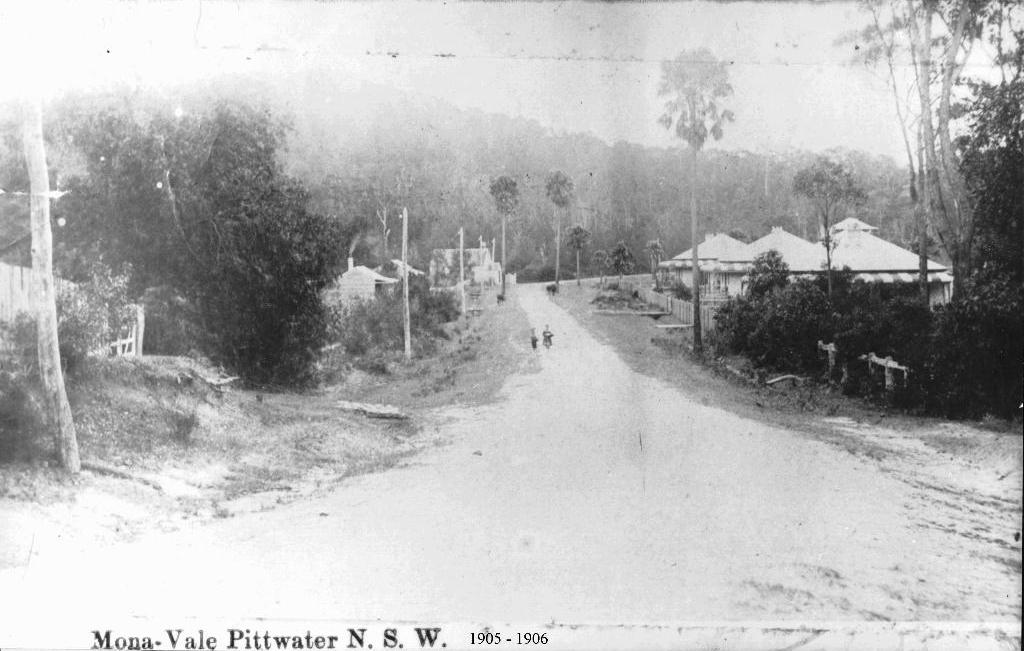
Mona Vale circa 1905 - looking towards Bayview. Mona Street runs off to the bottom right of this picture. To the left is St John's Church of England, which was moved in 1906. It is on this site that it was proposed to build Mona Vale Public school.
The name 'Mona Vale' is said to stem from the name David Foley gave to a farm he tenanted
EARLY MANLY.
MONA VALE SCHOOL.
A deputation Introduced by Dr. Arthur, M.L.A., yesterday urged upon the Minister for Public Instruction the necessity of opening a Public school at Mona Vale. It was suggested that either a new school building should be erected or the school at Church Point should be transferred to Mona Vale. The Importance of the place was rapidly growing owing to the subdivision of estates for residential purposes.
Mr. O'Conor said It appeared to him that the trend of the population was still unsettled. In addition to that the establishment of small schools was a great expense, and he was quite opposed to any material increase in the number of small schools. He would have a report made on the subject, but he reminded the deputation that the duty of parents did not cease on merely sending their children to school. He would arrange with the district inspector to confer with the parents to see it some satisfactory arrangement could not be come to. MONA VALE SCHOOL. (1906, May 2). The Sydney Morning Herald (NSW : 1842 - 1954), , p. 10. Retrieved from http://nla.gov.au/nla.news-article14768924
By Spring 1906 (some sources state July, 1906) the school at Bayview was closed, Mr. Morrison transferred to Mona Vale teaching temporarily in a premises owned by Samuel Stringer, of Park Street, with an assistant teacher in a Miss Selman helping him. The Morrison family moved to Manly at this time and Mr. Morrison travels by horse-drawn sulky to and from Mona Vale until he is transferred to Freshwater school in 1912 when that opened in September, or Spring, 1912..
Mr Stringer's daughter had begun teaching in Mona Vale around 1904. Samuel was a carpenter contracted by George Brock to build the stables, the ballroom and the Oaks villa on the Brock Folly Estate in 1902.:
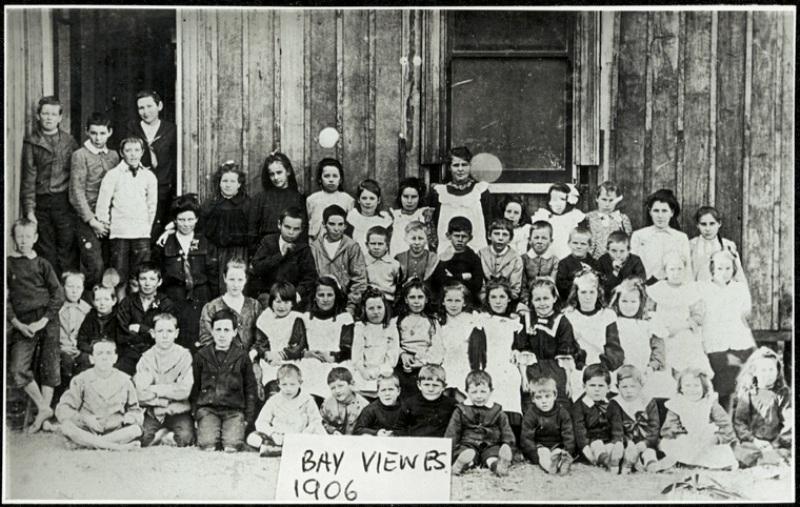
Bay View PS students 1906, Image No.: 15051_a047_000882, courtesy State Records NSW
Transfers and Appointments - Teachers: Mr. S. Morrison, from Newport to Mona Vale;SCHOOLS AND SCHOOL TEACHERS. (1906, September 5). The Sydney Mail and New South Wales Advertiser (NSW : 1871 - 1912), , p. 626. Retrieved fromhttp://nla.gov.au/nla.news-article163682045
Mr. S. Morrison, who for 22 years has keen in charge of the Bayview Public School, but who on the closing of the school was promoted to the new school recently established at Mona Vale, was presented on Wednesday with a handsome marble timepiece in appreciation of his services, and In recognition of his Interest in the pupils. The presentation was made by an old pupil, Mr. W. Austin. Mrs. Morrison was presented with a silver mounted hall set. PERSONAL. (1906, November 27). The Sydney Morning Herald (NSW : 1842 - 1954), , p. 6. Retrieved from http://nla.gov.au/nla.news-article14807260
Samuel Stringer arrived to Australia from England in 1859 with his parents Samuel Snr and Jane and his five siblings. They arrived aboard the ship Parsee. He married Sarah Anne Potter (born 1853) on the 20th of November, 1872 at Kelso, Bathurst. They had nine children.
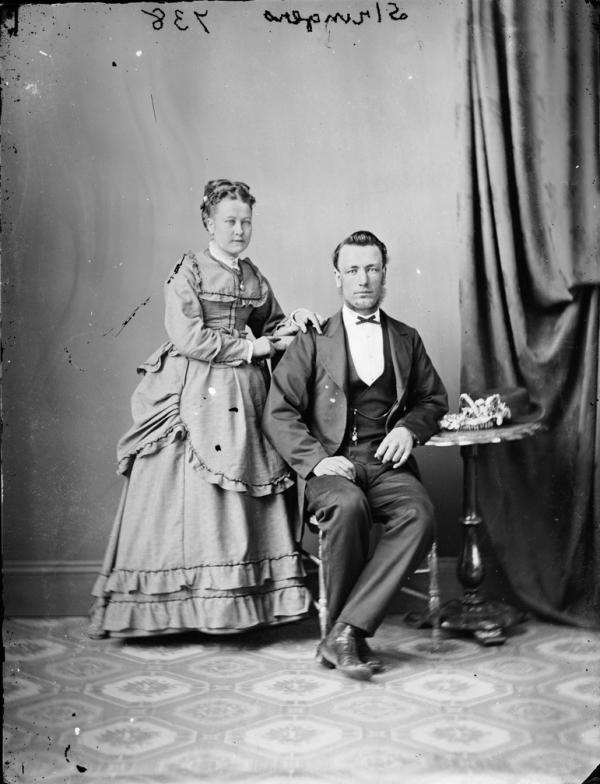
[Builder Samuel ?] Stringer and his wife [Sarah, nee Potter ?] circa 1870 -1875. Image No.: a2823823, courtesy State Library of NSW
Children of Sarah Ann Potter and Samuel Stringer are: William Charles Stringer, b. 1873, Hill End, John Henry Stringer, b. 1875, Pyrmont, Samuel G. Stringer, b. 1877, Sydney, Arthur Frederick Stringer, b. 1879, Pyrmont, Eva Annie J. Stringer, b. 1880, Pyrmont, Lilian May Stringer, b. 1882, Pyrmont, Eleanor "Nell" Mary Stringer, b. 1884, Pyrmont, Edith Annie Stringer, b. 1887, Pyrmont, Sydney, Lydia E. F. Stringer, b. 1888, Pyrmont.
"Mr. Stringer bought 6 adjoining blocks of land in Park Street Mona Vale for 125 pounds, which formed section 1 of the Mona Vale Estate. The vendor was Hon. Louis Francis Heydon and the sale was transacted on 21/07/1902. On 23/10/1903 Stringer borrowed 200 pounds from Heydon “for the purpose of building on the land”. Building is thought to have commenced in 1904. He also built the imitation sandstone cottage next to Dungarvon, No. 26 Park Street. In 1922 Stringer was over 70 years old and sold up Mona Vale and moved to Hurstville. He died in 1931." - Guy & Joan Jennings – Mona Vale Stories (2007)
This school was located in Park Street, Mona Vale:
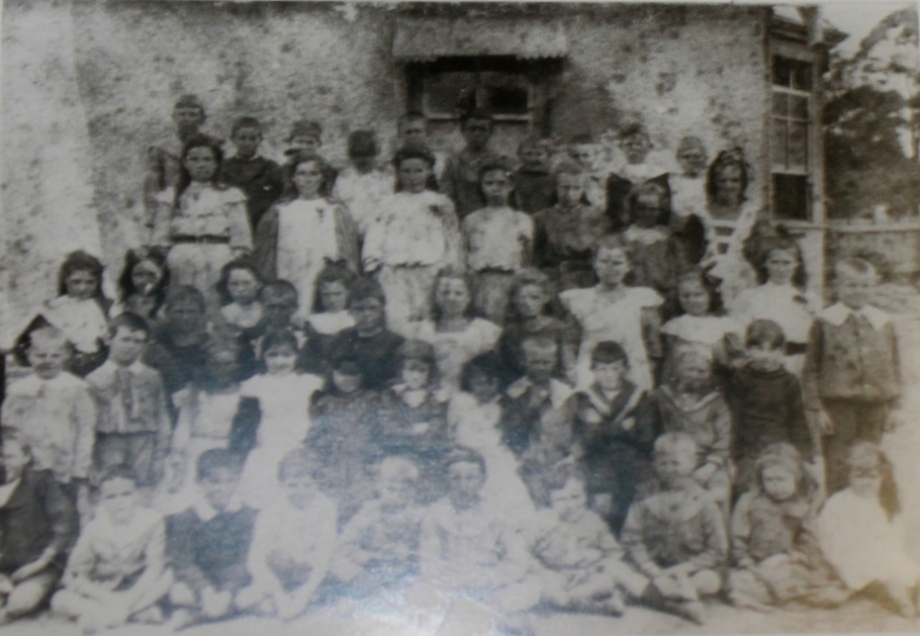
Mona Vale School in Stringers cottage, Park St, Mona Vale
“..Mona Vale had a population that demanded a Public School. Miss Stringer had opened a private school. There were too many children to convey to Bayview by coach, so the Department decided to close Bayview Public School and open one at Mona Vale. Two rooms of a new cottage belonging to Mr. Stringer were, with little difficulty converted into fairly comfortable schoolrooms.” - Samuel Morrison.
SCHOOL FLAG UNFURLED.
Mr. Hogue, Minister for Education, and Mrs. Hogue visited the Newport Public School on Saturday afternoon, and Mrs. Hogue unfurled the ling which the school has received from Newport, In the Isle of Wight, In exchange for one sent there some months ago. The flag, which is a Union Jack in large dimensions, is beautifully worked in silk, and bears the Newport arms in its centre. There was a large gathering of residents from the surrounding districts, and the children from the Newport, Narrabeen, and Mona Vale attended.
Mrs. Hogue broke the flag. As she did so the Kuringai Shire Band, which was in Attendance, struck up the National Anthem, and then three cheers were given for the flag. The children sang a number of patriotic songs, and appropriate speeches were made by Mr. Hogue and several others. SCHOOL FLAG UNFURLED. (1910, June 20). The Sydney Morning Herald (NSW : 1842 - 1954), , p. 10. Retrieved fromhttp://nla.gov.au/nla.news-article15160093
Visit: The Newport School 1888 to 2016
MONA VALE.-Empire Day celebrations commenced by the unfurling of a large Union Jack, presented by Mrs. F. Anderson. The children sang patriotic songs, and addresses were delivered by Mrs. Anderson, Messrs. Powell, Nichol, and Caton. After the distribution of prizes, refreshments were served to the children, who engaged in sports. EMPIRE DAY. (1911, May 27). The Sydney Morning Herald(NSW : 1842 - 1954), p. 9. Retrieved from http://nla.gov.au/nla.news-article15211332
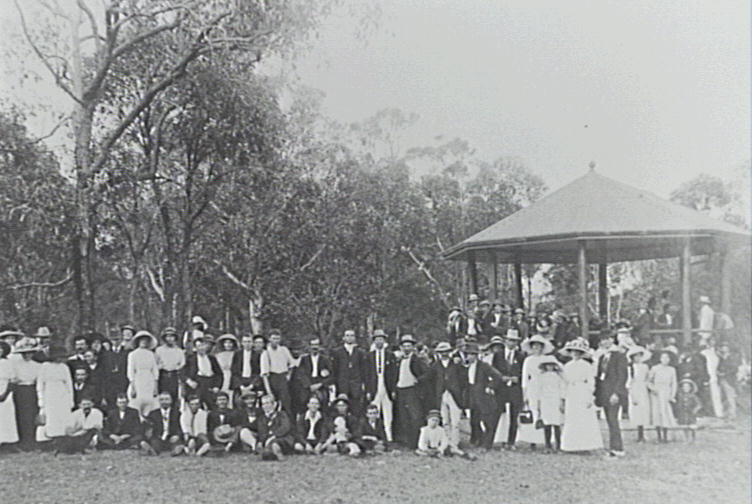
Spectators standing in front of bandstand at School picnic and sports day held in park, 1912. Courtesy Mona Vale Library Local History Unit.
On the 9th of March 1911 Mr. James Booth, the local stonemason, submitted a successful tender for the construction of a tiled two room schoolhouse. In the wonderful book compiled by Beverly Lewis for 100th Celebrations 'Mona Vale Public School - celebrating 100 years...' the rooms are described as "22' x 21'6, designed to accommodate 40 primary and 44 infants. A covered verandah, two fireplaces and grounds heavily covered in timber."
In October 1912 the school left the Stringer premises to the new schoolhouse in Narrabeen Street - a few Mona Vale schoolchildren insights from that time showing the children were kept aware of the world around them and also what was happening locally - such as the opening of the tram line to Narrabeen:
DISTRESS IN ENGLAND.
The Lord Mayor acknowledges the receipt of the following additional contributions to the fund established to relive the distress of starving women and children in Great Britain: Amount already acknowledged. £1418 3 0 "The Bulletin" .'.. 100 0 0
Children Mona Vale Public School, 13/ . 2 3 0 DISTRESS IN ENGLAND. (1912, April 8).The Sydney Morning Herald (NSW : 1842 - 1954), , p. 10. Retrieved from http://nla.gov.au/nla.news-article15323784
NARRABEEN TRAM. CHILDREN'S ESSAY PRIZES.
Children attending the Narrabeen, Mona Vale, and Newport Public School, at the Invitation of the tram opening celebration committee, wrote essays on 'The Pleasure to be Derived to the District.' The adjudicator, the editor of the 'Town and Country Journal,' has awarded the prizes as follows:— Narrabeen: Gertrude Hirsch. 1; Heather Thackery 2, Clement Snow, 3; Iris Lillington, 4. Mona Vale: Harold Hewitt, 1 : Ruby Kuhlmorgan. 3; Walter Peterson, 3; Richard Blackford, 4. Newport: Isabel Hastie. 1: Vera Russell, 1; John Williams, 3; Vera Lewis, 4. Sixteen competitors sent essays from Narrabeen, 17 from Mona Vale and 19 from Newport. The school masters, Messrs. Thompson (Narrabeen), Morrison (Mona Vale), and Harper (Newport) gave every assistance to the committee, and were complimented on the work of their pupils. NARRABEEN TRAM. (1912, July 19).Evening News (Sydney, NSW : 1869 - 1931), , p. 2. Retrieved from http://nla.gov.au/nla.news-article114480334
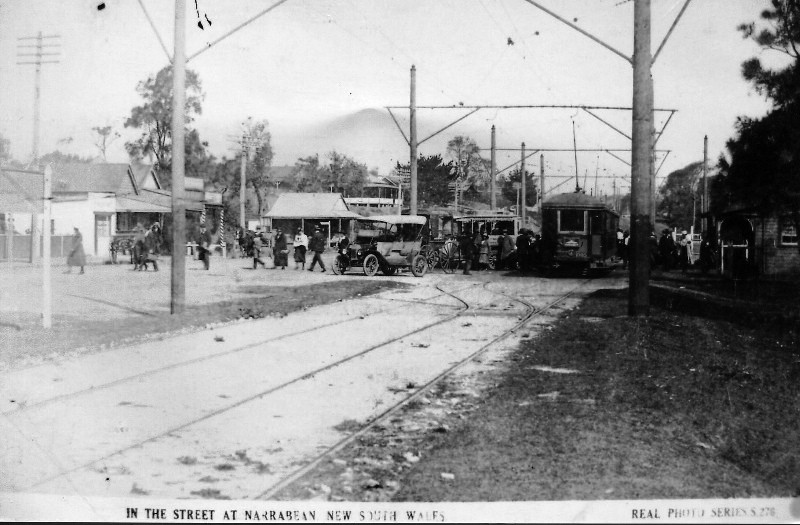
Narrabeen Tram. TOMORROW'S OPENING CEREMONY. BUILT BY DAY LABOR. The extesnion of the Narrabeen tramway from its present terminus to Collaroy Beach will be formally opened by Mrs. McGowan, wife of the Premier. The new l;ine runs to the southern end of Collaroy beach, a distance of 2 miles, 22 chains.
... The Track is a single one and was put down by day labour. ... The Departmental trial of the line was yesterday... The line will be in full running order tomorrow and will prove a great convenience to surf-bathers and week-enders who patronise the beaches and the attractive Narrabeen Lake...Narrabeen Tram. (1912, August 2). Evening News (Sydney, NSW : 1869 - 1931), , p. 5. Retrieved from http://nla.gov.au/nla.news-article114486950
NARRABEEN TRAM.
Commencing Monday next, the extension of tram line from Collaroy Beach to Narrabeen will be opened for traffic, and a regular service of trams will be run daily between Manly Pier and Narrabeen, connecting with steamers to and from Circular Quay.NARRABEEN TRAM. (1913, December 6). The Sydney Morning Herald (NSW : 1842 - 1954), , p. 22. Retrieved from http://nla.gov.au/nla.news-article28121325
COLLAROY-NARRABEEN TRAM.
The following adult rates for the conveyance of passengers on the newly-opened Collaroy Beach to Narrabeen tramway are gazetted:— Manly Pier and North Manly, 1d; North Manly and Spit-road, 1d: Spit-road and Brook-vale, 1d; Brookvale and South Creek-road, 1d: South Creek-road and Collaroy Beach, 1d; Collaroy Beach and Narrabeen, 1d. COLLAROY—NARRABEEN TRAM. (1913, December 11). Evening News (Sydney, NSW : 1869 - 1931), , p. 8. Retrieved from http://nla.gov.au/nla.news-article117957619
The Mona Vale congregation, by praiseworthy efforts, raised £25, and also purchased a new organ for the Church there. CIRCUIT LIFE AND WORK. (1912, October 19). The Methodist (Sydney, NSW : 1892 - 1954), , p. 11. Retrieved from http://nla.gov.au/nla.news-article155463010
The Transfer of Samuel Morrison to Freshwater and the new Headmaster's announcements:
School Teacher's Transfer.
Mr. W. I. Ross, the much-respected Public School teacher at Paterson, has received word of his appointment to the charge of the Public School at Mona Vale, near Manly. Paterson people will be sorry to lose Mr. and Mrs. Ross, but will congratulate them on their transfer to a place near Sydney, and amid delightful surroundings. School Teacher's Transfer. (1912, August 23). The Maitland Daily Mercury (NSW : 1894 - 1939), , p. 4. Retrieved from http://nla.gov.au/nla.news-article123121380
and the same may be said with regard to the Mona Vale community upon the addition of Mr. and Mrs. Ross to its numbers, Mr. Ross, as we intimated yesterday, having been appointed to take charge of the Mona Vale Public school. Branxton Public School. (1912, August 24).The Maitland Daily Mercury (NSW : 1894 - 1939), , p. 4. Retrieved from http://nla.gov.au/nla.news-article123111143
And a year afterwards - the first of many improvements to the school
PUBLIC SCHOOLS' IMPROVEMENTS. TENDERS ACCEPTED.
Mona Vale Public School, alterations to windows. R. Miles. Brookvale (£19). PUBLIC SCHOOLS IMPROVEMENTS. (1913, December 16). The Sydney Morning Herald (NSW : 1842 - 1954), , p. 5. Retrieved from http://nla.gov.au/nla.news-article15481811
World War I meant some of the early students of MVPS - formerly the Bay View and Church Point 'Pittwater Provisional Schools' went to serve their country - for the schoolchildren:
Wounded Soldier and Nurse.
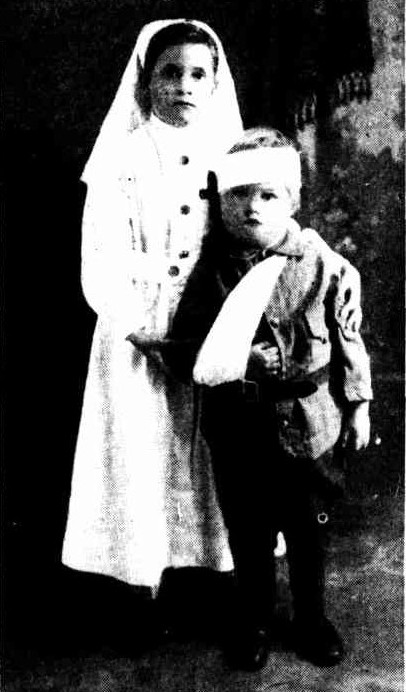
At a ball at Mona Vale, between Narrabeen and Newport, in aid of the Belgian Fund, little Patty Maley (daughter of Private Maley, who is now at the Dardanelles) appeared as a wounded soldier; and Mrs. Glamorgan's youthful daughter (whose brother is on the way to the front) was attired as a Red Cross nurse. Photo: Sweeney. Wounded Soldier and Nurse. (1915, July 14). Sydney Mail(NSW : 1912 - 1938), p. 31. Retrieved from http://nla.gov.au/nla.news-article162494200
The family of Cedric Moreton Williams, Elizabeth Hird (Nee Williams) and her daughter Dionne Challoner, and Cedric Vincent Williams kindly shared an image of their father (and grandfather), who was a student at Mona Vale, along with MVPS roll records - these were early students, including Mr. C. Williams Snr. - here in his MVPS school uniform of 1918:
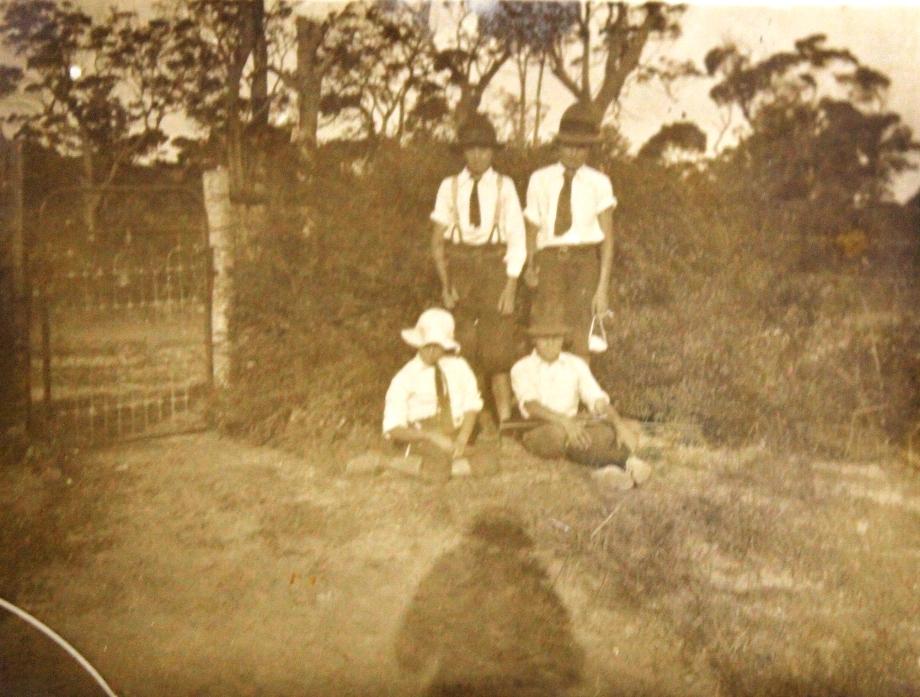
Caption on back of photo reads 'Tomas Campbell, Yours truly- (Cedric M Williams), John Wilson, Duglas Wilson - Mona Vale'
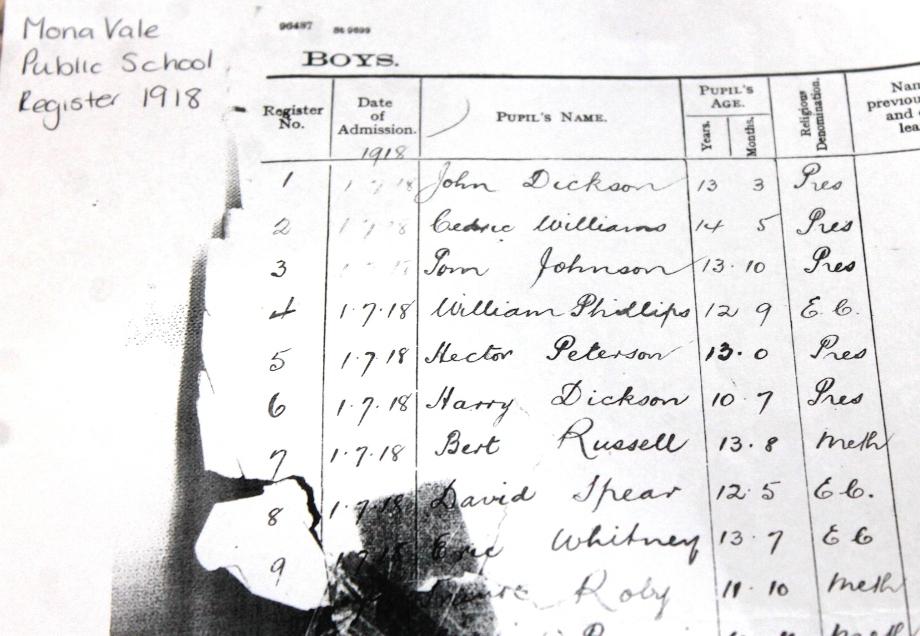
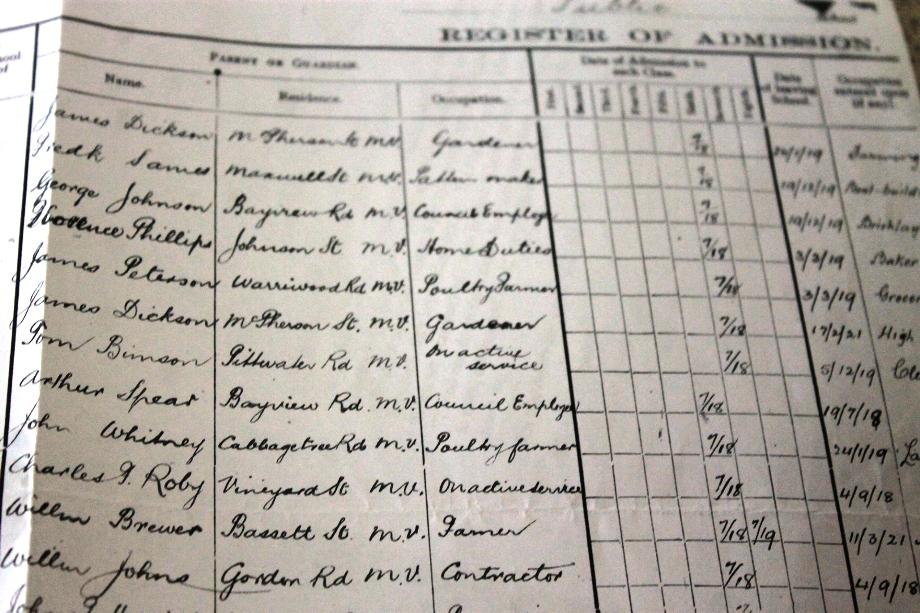

Above and Below: Panorama of Mona Vale, New South Wales, ca. 1930 [picture] / EB Studios National Library of Australia PIC P865/125 circa between 1917 and 1946] and sections from made larger to show detail. See: Pittwater Reserves - The Green Ways: Mona Vale's Village Greens a Map of the Historic Crown Lands Ethos Realised in The Village, Kitchener and Beeby Parks
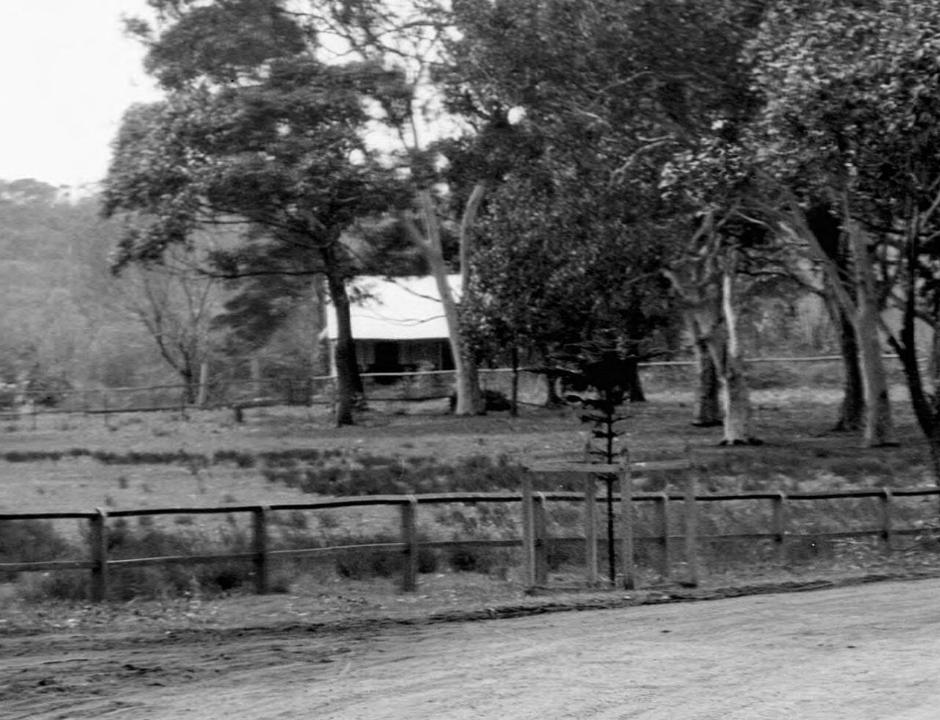
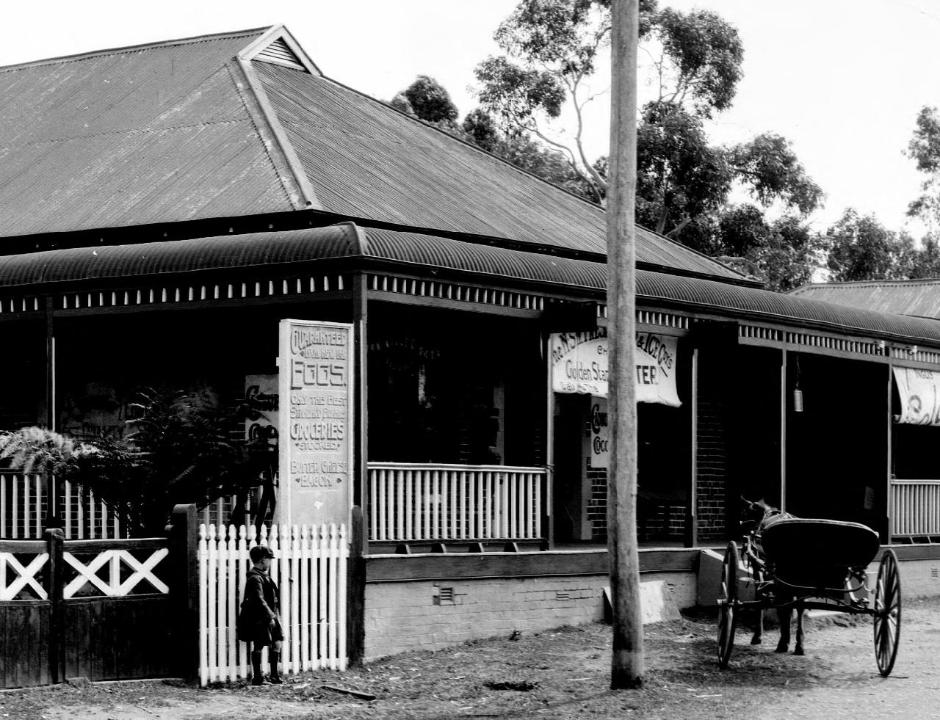

1918, the year WWI ended with the Armistice of November 11, 1918, brought disaster of a kind to Mona Vale - Elizabeth Hird related that her father was enrolled as number 2 at a new Mona Vale School - a fire in mid 1918 explains why:
SCHOOL ATTENDANCES
Improvement Follows Truancy Act
MONA VALE'S RECORD
The Minister for Education, Mr. James, drew attention to-day to the remarkable improvement in, school attendance 'as the result, he said, of the operations of the Truancy Act.
The last December quarter's attendance, is easily a record since the department has been in existence. Statistics are now complete for the metropolitan urea, which is divided into nine inspectorial districts. The attendance in districts shows quite a remarkable uniformity, ranging from 85.1 to 86.4 per cent. The little school at Mona Vale, near Manly, has the distinction of maintaining the highest average attendance during the December quarter, reaching 93 per cent. In the boys' department Glebe Superior Public School tops tho list with 92.4 per cent., while Burwood and Newtown divide second honors with 92.3 per cent. The statistics show that the attendance of girls' departments in the majority of cases is from three to four per cent, below that of tho boys', although in a Jew instances the attendance in the girls' department exceeds that in tho boys'. Tho highest average attendance reached in any girls' department was at Bourke-street, Surry Hills, with 90.4 per cent., Fort-street and Paddington just failing to reach 90 per cent with 89.9, and Drummoyne running close With 80.8. In the infants' department Enmore tops the list with' 89.2, Rockdale being second with 87.2. The distinction of reaching the highest attendance in all three departments — boys, girls, and Infants — Is shared by the Summer Hill and Glebe Superior Schools, which tie With 8S.8 per cent. Only two boys' departments throughout the whole metropolitan area fall below 85 per cent., while 13 boys' schools exceeded 90 per cent. Nineteen .girls' departments range from 80 per cent, to 85 per cent., but only one girls' department exceeded 90 as against 13 boys' departments which topped 9). In tho Infants' department, nine fell below 80 per cent., while 41 ranged from 80 to 85. "I have given Instructions," said Mr. .Tames, "that special attention should be paid by the attendance officers to every school where the attendance drops below 85 per cent." SCHOOL ATTENDANCES (1918, January 21). The Sun (Sydney, NSW : 1910 - 1954), , p. 2 (FINAL EXTRA). Retrieved from http://nla.gov.au/nla.news-article221948564
The Sunshine Girls have had a busy time lately.. The week before last they visited Picton in aid of the local War Chest, and they entertained returned men of the 3rd Battalion at Macdonell House on two occasions. On June 1, they played at Kellyville in aid of comforts for local boys at the front, and last night they, gave a performance at Mona Vale to obtain funds for Christmas parcels for the soldiers who are fighting from that district. Social gossip (1918, June 9). The Sun (Sydney, NSW : 1910 - 1954), , p. 14. Retrieved from http://nla.gov.au/nla.news-article221951542
PUBLIC SCHOOL DESTROYED
The public school at Mona vale was destroyed by fire late last night. PUBLIC SCHOOL DESTROYED. (1918, June 14). The Maitland Daily Mercury (NSW : 1894 - 1939), , p. 5. Retrieved from http://nla.gov.au/nla.news-article122648648
The school was only partially destroyed and repaired. A Roll of Honour, dedicated on March 23rd, 1918, was replaced.
SCHOOL MEMORIAL - Mona Vale Boys Honored
Yesterday Sir Granville Ryrie unveiled a tablet to the memory of the soldiers who as boys, had attended the Mona Vale School. The tablet contained the names of 35, four of whom made the supreme sacrifice, and four had gained distinction on the field. After eulogising the deeds of the Australians on distant battlefields, General Ryrie implored the rising- generation to maintain the traditions of their'' race, and to shim, as unclean, the propaganda of those who were out to wreck the Empire, and bring about the undoing of Australia. Mr. A. G. Parr, President of the Warringah Shire Council, pointed out that the percentage of those who had enlisted from the shire, compared more than favorably with any other district in the State. Many of the old boys who had served in the war were present, and an old Crimean veteran, Mr. W. Brown, gave some interesting details of old-time wars, and strongly urged his hearers to be guided by General Ryrie's words. SCHOOL MEMORIAL (1921, September 25). Sunday Times (Sydney, NSW : 1895 - 1930), , p. 2. Retrieved from http://nla.gov.au/nla.news-article123237285
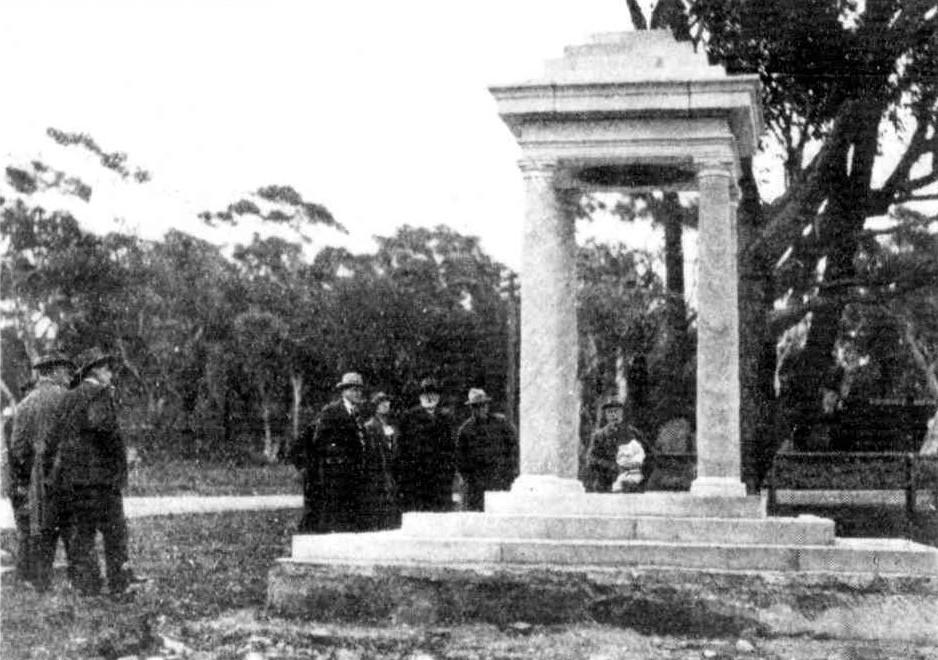
SOLDIERS' MEMORIAL AT MONA VALE. Members of the Royal Australian Historical Society inspected the memorial on their way to Avalon Beach, between Newport and Barrenjoey, on Saturday. From: A Week-End Miscellany : History, Charity, and Sport. (1926, August 25). Sydney Mail (NSW : 1912 - 1938), p. 10. Retrieved from http://nla.gov.au/nla.news-article166523535
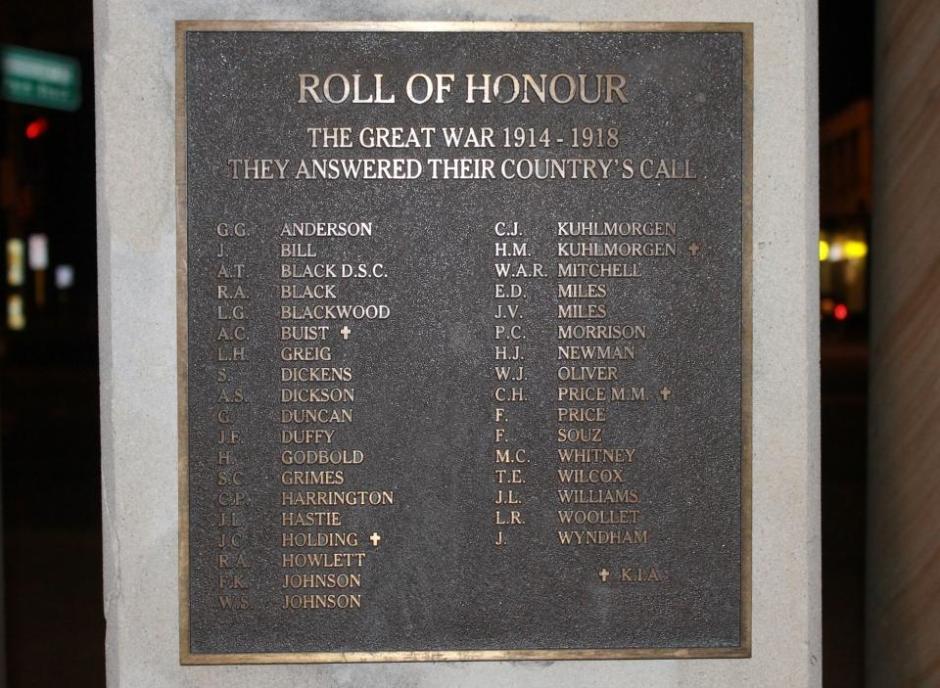
In November 1918: Mr. D. Macrae, from Wilberforce (relieving) to Mona Vale - Government Gazette
Another rural teacher is sent to still relatively rural Mona Vale
LEURA'S HEADMASTER.
TRANSFERRED TO MONA VALE.
General regret is felt in Leura at the impending departure of Mr. J. Ray, headmaster of the public school. Mr. Ray has been a resident of Leura for ten years, during which time he took a prominent part in the public life of that centre.- He has now been transferred to Mona Vale, and will be succeeded by Mr. Rawsell, from Dunedoo. A fitting farewell is being arranged. LEURA'S HEADMASTER. (1922, July 24).Lithgow Mercury (NSW : 1898 - 1954), p. 2. Retrieved from http://nla.gov.au/nla.news-article219702961
Records indicate numerous repairs and improvements at Mona Vale, but one seems to have been overlooked, for a month or two
MONA VALE SCHOOL.
Writing to the Editor, Mr. D. J. Duffy says that the Mona Vale Public School has no permanent water supply. The children at the school are compelled at times to drink putrid water, caught in tanks and drained from the roof, where many birds lodge, or to carry their supply-from their homes. MONA VALE SCHOOL. (1927, December 14). The Sydney Morning Herald (NSW : 1842 - 1954), , p. 17. Retrieved from http://nla.gov.au/nla.news-article16426462
Public school improvements
Mona Vale: Additions, Pollock and Pollock, Epping £968. GOVERNMENT CONTRACTS. (1928, February 22). The Sydney Morning Herald (NSW : 1842 - 1954), , p. 11. Retrieved from http://nla.gov.au/nla.news-article16443894
School Teacher Retires.
On the occasion of his retirement, the Parents and Citizens and staff, pupils and ex-pupils of Mona Vale school, tendered a farewell dance to Mr. J. Whiting, B.A. and Mrs. Whiting, when they were presented with a Jacobean reading lamp, lounge chair and many other beautiful gifts. The hall was thronged with wellwishers, and after a delightful supper the proceedings closed with the singing of Auld Lang Syne. The fellow teachers of Mr. J. Whiting, B.A., of Mona Vale, who recently retired from the Education Department after a long and distinguished career, are tendering him a farewell presentation at the Manly Public School. Mr. Whiting joins the lengthening roll of retired teachers who have taken up residence in the Manly and Warringah Shire. (Mr. Whiting at one time was Headmaster of Walcha Public School, and is the father of Mrs. Mervyn Waller.— Ed. W.N.). School Teacher (1935, August 30). The Walcha News (NSW : 1932 - 1935), , p. 1. Retrieved from http://nla.gov.au/nla.news-article191031472
In Mona Vale's Centenary year of 2012 the talk given by Margaret Collins at the Launch, a past Infant Mistress and for whom a current Citizenship Shield at MVPS is named, described the environment. Miss Collin’s, whose father was a Principal at the school from 1936, and who was a student herself, saw tall trees and masses of them in Mona Vale, paddocks with horses surrounded the school, some children coming from Bayview and Warriewood on these to attend. She recalled the extension of the school grounds and how Oliver Way, on the southern boundary of the present school, was formed due to land being donated by the Oliver’s of Bayview. Miss Collin’s relating of playing marbles under a Bunyip pine, which also once marked the fences border.
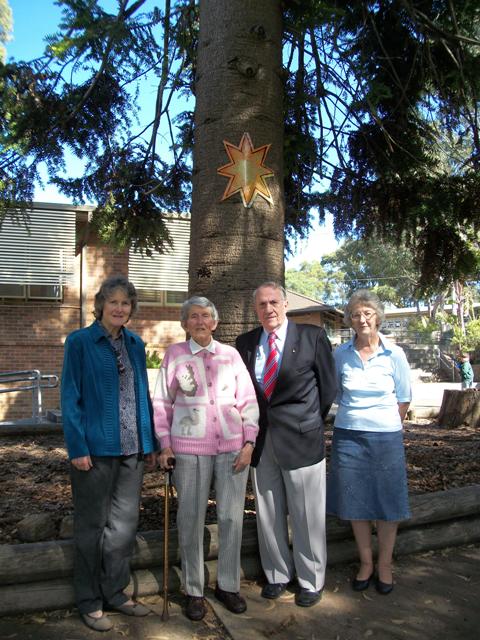
Left to right: Beverly Lewis(who has wrote the book on History of MVPS, Margaret Collins, Richard Hoskins AM, and Beverly Harvey under the Bunyip pine
A growing younger population required a bigger school with bigger grounds:
NOTIFICATION OF RESUMPTION OF LAND UNDER
THE PUBLIC WORKS ACT, 1912.
IT is hereby notified and declared by His Excellency the Governor, acting with the advice of the Executive Council, that be much of the land hereunder described as is Crown land has been appropriated, and so much thereof as is private property has been resumed, under the Public Works Act, 1912, for the following public purpose, namely, a Public School at MONA VALE, and is vested in the Minister of Public Instruction on behalf of His Majesty the King for the purposes of the Public Instruction Act of 1880.
Dated the thirtieth day of April, one thousand nine hundred and forty-seven.
J. NORTHCOTT, Governor. By His Excellency's Command,
R. J. HEFFRON, Minister of Public Instruction.
Description of Land referred to.
All that piece or parcel of land situate in the Shire of Warringah, parish of Narrabeen, county of Cumberland and State of New South Wales, being allotment 10 of section 7 in the village of Turimetta,—having an area of 1 rood and 37h perches or thereabouts, and said to be in the possession of Thomas Dudley Leafe (administrator of the estate of Thomas Leafe, deceased).
Also, all that piece or parcel of land situate as above, being allotment 11 of section 7 in the village of Turimetta,—having an area of 1 rood and 32 perches or thereabouts, and said to be in the possession of Hugh Rusden Oilman.
Also, all that piece or parcel of land situate as above, being allotment 12 of section 7 in the village of Turimetta, and also being the land comprised in Conditional Purchase No. 44-53 (Metropolitan Land District),—having an area of 1 rood and 32 perches or thereabouts, and said to be in the possession of Rudolph Frederick William Edward Wilkinson. NOTIFICATION OF RESUMPTION OF LAND UNDER THE PUBLIC WORKS ACT, 1912. (1947, May 16). Government Gazette of the State of New South Wales (Sydney, NSW : 1901 - 2001), p. 1148. Retrieved from http://nla.gov.au/nla.news-article224768714
Land District—Metropolitan; Shire—Warringah
At Mona Vale, Village Turimetta, Parish Narrabeen, County Cumberland, closed road separating allotments 4 and 5 from allotments 9 and 10, section 4. 14 1/2 perches (added to area of 1 acre 3 roods 0 perches dedicated for Public School Site on 24th October, 1906). Plan Turimetta5. R. 64-184. ADDITIONS TO DEDICATIONS (1967, September 15). Government Gazette of the State of New South Wales (Sydney, NSW : 1901 - 2001), p. 3397. Retrieved from http://nla.gov.au/nla.news-article220028716
Mona Vale Public School Tree Planters: Students from the Village Green become those who are Greening the Village
ARBOR DAY. School Celebrations.
Arbor Day was celebrated yesterday In schools under the Education Department, most of-which planted trees in honour of the Coro-nation of the King and Queen. Trees were also planted in honour of Princesses Elizabeth and Margaret Rose.
A party representing the Education Department and the Australian Forest League visited schools in the Warringah Shire. At Harbord public school the headmaster announced that all the children were tree wardens and they repented in unison their promise "not wilfully to destroy but to protect daily our trees and wild flowers."
At Brookvale school the Director of Education (Mr. G. R. Thomas)announced that next year for the 150th anniversary, he would invite all schools to plant three , wattle trees one in honour of Captain Cook, one for Governor Phillip,, and one symbolical of "Peace."
At Mona Vale, Western Australian flowering gums were planted by two pupils, while the other children danced round in a circle.
Many of the trees planted yesterday were supplied by the State nursery at Gosford, and a feature of this year's planting was the setting of more varieties of native trees than on any previous Arbor Day. Help was given by municipal and shire councils. ARBOR DAY. (1937, July 31). The Sydney Morning Herald (NSW : 1842 - 1954), , p. 14. Retrieved from http://nla.gov.au/nla.news-article27984916
Mona Vale Public School Plants 140 Trees In Three Streets
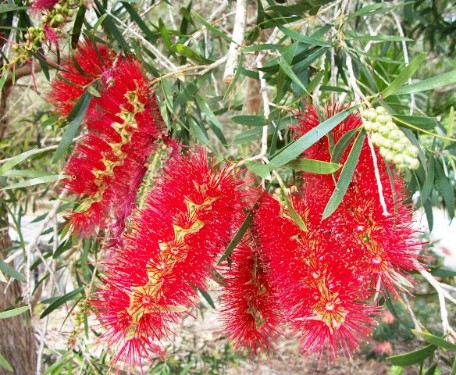 ONE hundred and forty Bottle Brush trees were planted at Mona Vale on August 11, when Arbor Day was celebrated at Mona Vale School.
ONE hundred and forty Bottle Brush trees were planted at Mona Vale on August 11, when Arbor Day was celebrated at Mona Vale School.
The trees were planted in Narrabeen, Waratah and Park streets, which surround the school, at which 148 students have become tree wardens.
The tree planting was arranged by the schoolmaster, Mr. Daly with the co-operation of the Parents and Citizens' Association. ;
- The P. &. C. and school children bought most of the treelings from the Forestry Department, the Department giving the remainder.
Mr. Daly addressed the gathering of children, parents and visitors, after which Mr., Austin, inspector of schools, Mr. Asian; M.L.A., and Mr. Watson, of the Naturalist: Society, addressed the large gathering.
All spoke of the great value of trees to the individual, the community, and the nation, and urged the growing, care, and protection of trees.
Trees were living things of beauty and great usefulness, and every effort should be made to save them from damage and destruction, the speakers said.
The young trees were distributed among the visitors, children and members of the Parents and Citizens' Association who moved to positions in the three streets where the treelings were planted.
Other visitors included members of the N.S.W. Town Planning Association (Mr. and Mrs. B. W. Ford), the president of Warringah Shire Council(Mr. R. Kent),- a member of the Forestry Advisory Committee (Mr.Turner), the secretary of Pittwater R.S.L. (Mr. Bimsan), Mrs. Ingleton, representing the Mona Vale Community League, and Mr. and Mrs. E. H. Collins.
The president of the P. and C. Association (Mrs. K. Batten) assisted by the secretary (Mrs. O. Anderson)entertained the visitors at lunch, while the school children provided a bright concert programme, which included Master Ted Budge's vocal solo, "Trees."
Visitors paid tributes to the school staff, P. and C. members, and all who assisted in the tree planting and entertainment. MONA VALVE SCHOOL PLANTS 140 TREES IN 3 STREETS. (1950, August 25). The Land (Sydney, NSW : 1911 - 1954), p. 14. Retrieved from http://nla.gov.au/nla.news-article105713567
Schools Celebrate Arbor Day In The Rain: Children’s Enthusiasm
By Our Special Representative.
'THE growing interest among school children in the planting and protection of trees was demonstrated last Friday at Arbor Day ceremonies at public schools in seaside resorts north of Sydney.
To celebrate Jubilee year and in support of the Festival of Trees special ceremonies had been arranged at Avalon, Newport and Mona Vale. These districts are well known surf and holiday resorts, but with increased building development they axe rapidly becoming suburban residential areas.
This part of our northern coastline is well endowed with trees and the undulating country sweeping down to the sea provides many picturesque vistas. With the change to suburbia., however, many of the tree clad hills are showing the effects of the axe and the five stick. As land is subdivided and building blocks cleared trees have to come down to make way for progress.
People Tree Conscious
A tour of the district last Friday during the school Arbor Day ceremonies revealed that many of the local public bodies and residents are tree conscious and are anxious to preserve as much as possible of the district's natural beauty.
The schools at Avalon, Newport and Mona Vale, therefore, received generous support in their tree planting programmes from their own parents and citizens' associations and other local organisations.
Be cause of continuous heavy rain Arbor Day was celebrated at the three schools with only token plantings of trees.
The extremely wet conditions, however, appeared to act as a spur to the enthusiasm of the youngsters and their parents and friends. Programmes of songs, physical culture exercises, verse speaking and tableaus were performed indoors or in the open in those few brief moments when the rain eased.
R.S.L. Support
The first ceremony was at Avalon, where the local sub-branch of the R.S.L. had provided the trees for a planting programme in the school grounds.
This is a comparatively new school. Only temporary buildings have been erected so far I and there is plenty of scope for tree planting in the four acres of grounds.
The headmaster, Mr. T. E. L. McGuire, explained that a master plan had been prepared on the advice of a nurseryman for laying out and planting the school grounds with trees and shrubs. The plan provides for windbreak and shade trees, an agricultural section and a properly equipped playground.
After the children had given several items short addresses on the value of trees and the need for their protection were delivered by Mrs. A. Wyatt, a vice-president of the Forestry Advisory Council and a member of the Kuring-gai 'Tree Lovers' Civic League, and Mr. E. Breakwell, former organiser of Junior Farmers' Clubs, and representing the Australian Forest League.
Mr. Breakwell, who is well known throughout New South Wales for his work in the interests of school agriculture and tree planting, is now residing at Newport. He continues to take a moist active interest in the local schools and is particularly keen on the development of a tree consciousness among school children and the public generally.
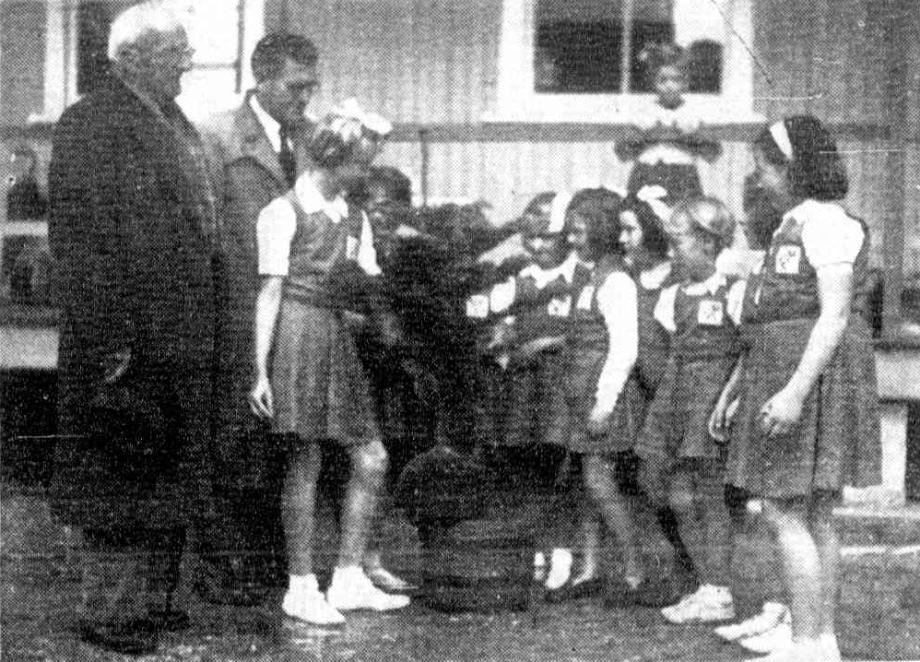
LEFT (above): MR. BREAKWELL, former organiser of Junior Farmer Clubs throughout N.S.W. and representing the Australian Forest League, took a prominent part in the tree-planting ceremony at Avalon Public School, The headmaster, MR. T. E. L. McGUIRE, is also in the picture.
With due ceremony a Norfolk Island Pine, one of many to be planted on the southern boundary, was "planted" in a large pot indoors, while the children recited the tree warden's pledge.
At Newport the headmaster, Mr. N. R. Sanderson, had organised a splendid programme which was performed despite the rain. Here again, however, it was impossible to carry out the tree planting'portion of the programme.
But: the singing of "Trees" by the school choir, the clear young voices ringing out in the rain-washed air amid a lovely setting of trees, was ample compensation for those who braved the wintry weather to attend.
Cavalcade of History
The highlight of the day's events, however, was at Mona Vale, where a most elaborate and well organised programme had been arranged to celebrate Jubilee Year and Arbor Day.
The school children, in full costume and with scenery and effects, took part in what was really a cavalcade of Australian history.
The headmaster, Mr. G. B. A. Daly, was responsible for the arrangement of- the performance and': had valuable assistance and co-operation from his teaching staff and members of the Parents and, Citizens' Association.
Providence was kind at this stage. The rain ceased and fitful sunlight shone out as Capt. , Cook landed from the Endeavor and was greeted by a large band of aborigines, to be followed by colorful scenes from Australia's past, with Redcoats marching to the beat of a vigorous drummer, pioneers pushing out to conquer the outback, statesmen telling of the development of a hation and the three arms of the present-day services marching proudly across the parade ground.
The programme ended with a salute to "Australia" and "Britannia."
Performance Praised
The performance was excellent and won high praise from, Mr. J. N. Harrison, the district inspector of schools, who described it as one of the most outstanding Jubilee Year events he had witnessed.
Three of the "actors" then planted a tree in the school ground to mark the Jubilee Year Arbor Day. It had been intended that 80 advanced trees would be planted but, owing to the rain, this major planting had to be postponed.
(Continued on page 10)
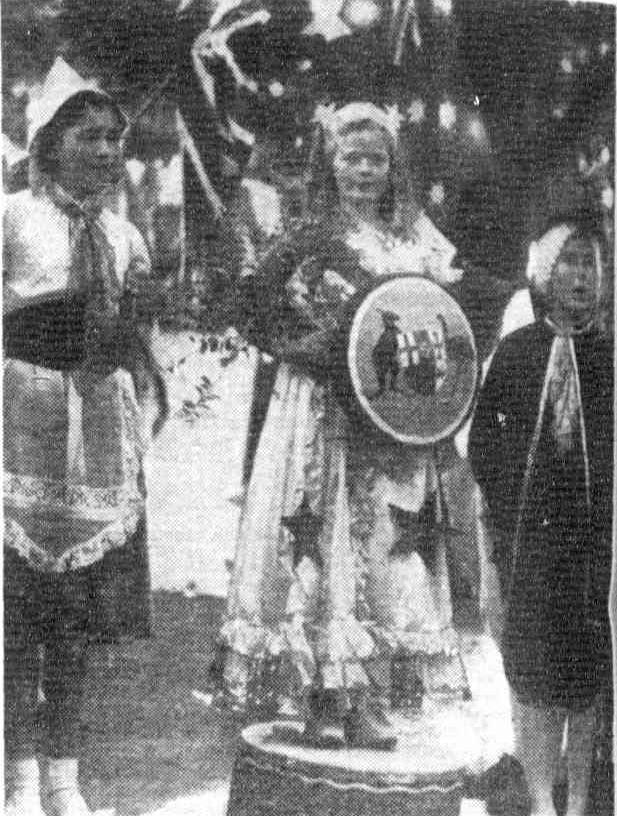
SALUTE TO "AUSTRALIA" "Australia" and her attendants made ct colorful picture In the final tableau of the Jubilee Year performance given by Mona Vale schoolchildren last Friday. The performance was given as part of the Arbor Day ceremony at the school.
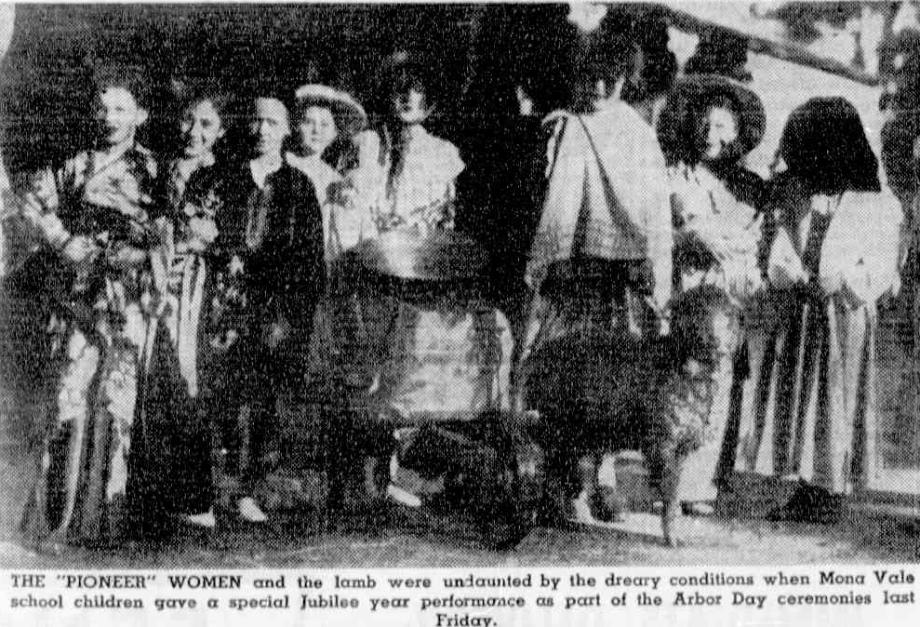
THE "PIONEER" WOMEN and the lamb were undaunted by the dreary conditions when Mona Vale school children gave a special Jubilee year performance as part of the Arbor Day ceremonies last Friday.
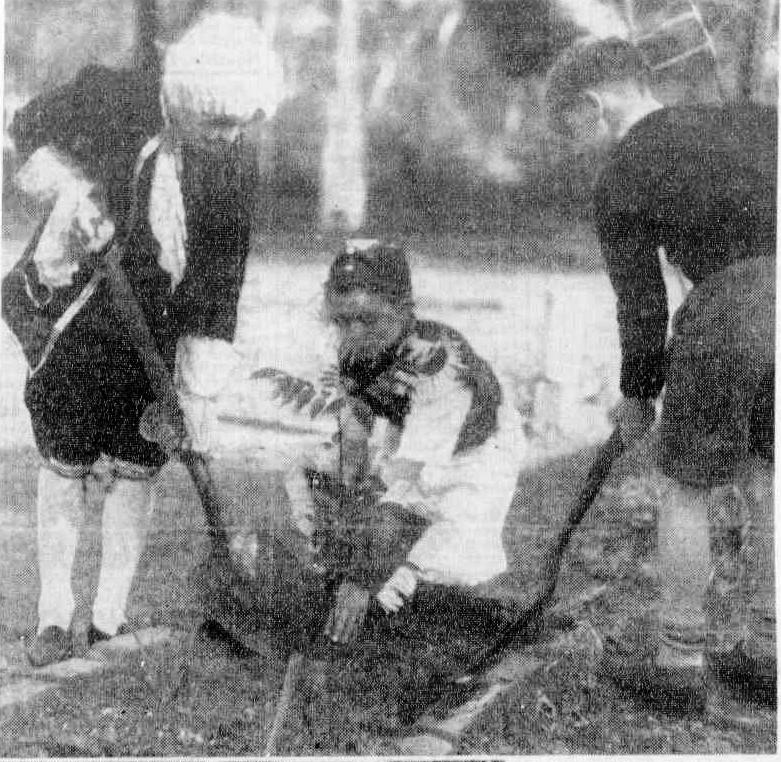
JUBILEE TREE PLANTING at Mona Vale Public School. MASTERS HOGAN (centre). WILLIAMS and TORA plant a tree in the school ground after pupils had given a Jubilee year performance in costume. Schools Celebrate Arbor Day (Continued from page 8) Schools Celebrate Arbor Day In The Rain; Children's Enthusiasm (1951, July 6).The Land (Sydney, NSW : 1911 - 1954), , p. 8. Retrieved from http://nla.gov.au/nla.news-article112489300
And who might that darling young 'Williams' boy be? Looks about 8 years old -: Cedric Vincent Williams?
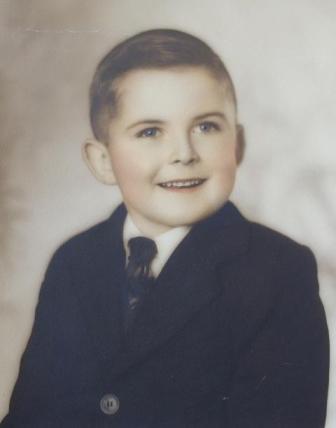 From Cedric V. Williams generous sharing of a few insights of the Pittwater of his younger years through his Profile page:
From Cedric V. Williams generous sharing of a few insights of the Pittwater of his younger years through his Profile page:
"I was born in Manly on the 18th of September 1938. we moved two days later to Bayview. I lived in Bayview all of my young life. We then moved further around in Bayview.
What was it like growing up in Bayview – what did you do for fun?My father was Cedric Morton Williams whereas I’m Cedric Vincent Williams – Vincent came from my uncle who lived at Avalon before you could actually get there by road and had to go by boat.
Bayview was a strange spot as the only way you could go to school was to go to Mona Vale. There was only 8 to 10 young people in Bayview at that time. We went over the hill, into the bush occasionally, but I was mainly on the water.
Right: what a beautiful picture of a wonderful local boy - just starting at school
My father had the boatshed and the boat building business and so I’d go down to the boatshed most of the time.
When I was at school I was building VJ’s – so I’d get home from school and build boats. I went from Mona Vale school to Manly High, which had just moved into Harbord when I was in my 3rd year. My apprenticeship then came back to Bayview so I worked at Bayview form then on.
The school was one of those listed as needing new classrooms. There are many listings in the government Gazette of 'Improvements past this decade -every thing from Louvre doors, Folding Partitions, Painting and supplying and installing aluminium doors and window frames - prior to then this community school utilised other structures in the community to meet the needs of students:
Grave, Critical Overcrowding In Many State Schools
By OUR EDUCATION CORRESPONDENT
The much-vaunted system of free, compulsory and secular public education in New South Wales is faced to-day with a set of interrelated problems of the utmost gravity, which, as a result of ignorance and apathy, have reached a critical stage.
The immediate problems fall into three categories: That of building enough schools and classrooms for an ever-increasing number of children; that of the curriculum by which the children are taught; and that of the way in which teachers are recruited and trained, and their rates of pay.
THESE problems, in the opinion of most educationists, are them-selves effects rather than causes. They have arisen because of the centralised structure of the public education system and its continued subordination to the N.S.W. Public Service Board.
This board, charged with the responsibility of maintaining some kind of uniformity in the administrative services of the State, has never shown a conspicuous grasp of the nature of true education or the essential means which must be adopted to attain desirable ends in that field.
It would be unfair to place the entire blame upon the Public Service Board. An equal share of the blame must be accepted by successive New South Wales Cabinets, first for their parsimony over many years where education has been concerned, and secondly for their failure to prevent de facto control of educational policy falling ever more into the hands of the board and the Treasury.
• MONA VALE: Two class-rooms short. One class is in the corridor. Another uses a church hall a considerable distance from the school. Grave, Critical Overcrowding In Many State Schools (1954, February 24). The Sydney Morning Herald (NSW : 1842 - 1954), , p. 2. Retrieved from http://nla.gov.au/nla.news-article18411594
And when did the original structure disappear:?
Mona Vale Public School—Ground improvements. – 1963 Mona Vale Public School—Demolition of Old Stone School - 1966Department of Public Works—Tenders for Works (1966, August 26). Government Gazette of the State of New South Wales (Sydney, NSW : 1901 - 2001), , p. 3541. Retrieved from http://nla.gov.au/nla.news-article220024648
MVPS - 2012 100 Years Celebrations Festival Day: September 15, 2012

Extras:
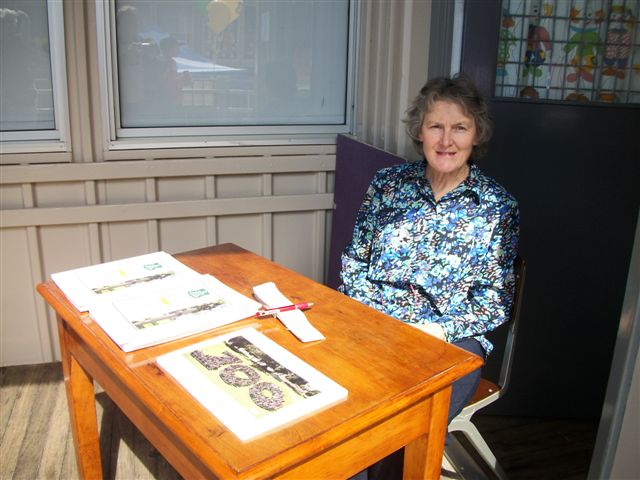
Beverly Lewis, past teacher at MVPS with her excellent MVPS History .
THE STORY OF MONA VALE.
[Some of the facts disclosed below are so strange, and the condition of things stated to have prevailed for a long period and even to be yet existing, at Pitt Water, so extraordinary, that the writer thinks it necessary to say that, his information having been derived from investigations made personally on the spot, and confirmed in all essential particulars by official and other documentary evidence, the truth of the statements may be fully relied upon. — ED. Empire.]
EVERY person in the habit of paying the slightest attention to the proceedings in our local criminal courts, must have noticed for seven years past frequently recurring cases involving charges and counter-charges of perjury, cattle-stealing, assaults, and other crimes between the members of certain families residing in the district of Pitt Water. The latest result of these criminal charges is that one of the litigants named Farrell, a man of considerable property, both freehold and personal, is now undergoing a sentence of seven years' hard labour. He was convicted on the 30th December, of the malicious destruction of cattle, the property of a Mr. Therry, his nearest neighbour. The counter charges brought by Farrell, before his conviction, against Mr. Therry and members of his family, were all dismissed by the magistrates before whom they were investigated, and the result clearly proved that they were concoctions of the most base and wicked description. While these charges and counter charges were pending, we thought it necessary to refrain from publishing many facts which had come to our knowledge respecting the persecution and ruin of the Therry family, and of previous occupants of the Mona Vale estate, by unprincipled neighbours, during a period extending over nearly a quarter of a century. The story of the misfortunes of the family who are at present tenants of the farm of Mona Vale is a most distressing one, and would, if not confirmed by undoubted testimony, be utterly incredible. But bad as have been the sufferings, and great as have been the wrongs of the Therrys, they have, so far, escaped with their lives, while one, at least, of their predecessors at Mona Vale was foully murdered, in addition to having been persecuted and plundered of his property. The state of things which has prevailed at Pitt Water during the last twenty or twenty-five years has been such, it is to be hoped, as has never before prevailed in a Christian or any other country.
To make the circumstances connected with the wrongs and sufferings of the Therry family intelligible, it is necessary to give something like a twenty five years' history of the locality in which they live. The district called Pitt Water, as most of our readers are probably aware, is a part of the county of Cumberland, situate on the coast between Port Jackson and Broken Bay. It commences about eight miles north of Manly Beach, and extends along the shores of the Pacific for ten or twelve miles to the waters of Broken Bay. The first farms granted to private settlers, after the formation of the settlement at Sydney Cove in 1788, were in this district, and informer times a considerable quantity of land was in cultivation there; but for many years past the farms have been almost exclusively used for grazing and dairy purposes. There are not now above eight or ten families in the whole district, although, when tillage was more extensively pursued, the population was larger.
Near the middle of the Pitt Water district, that is, about a dozen miles from Manly Beach, is situated the estate of Mona Vale, at present in the occupation of Mr. Therry, as tenant of the heirs or trustees of the late Captain Darley. Mr. Therry's nearest neighbours on the south, or Manly Beachside, are a family part of whose members are named Collins and the others Poyner. On the north, or Broken Bay side, his nearest neighbours are the Farrells. It is the head of the latter family who is now undergoing a sentence of hard labour as before mentioned. Poyner, a near relative of the Collinses, and an inmate of their house, not long since finished a sentence of hard labour at Cockatoo for horse-stealing Collins, so far as is now known, has not been convicted of crime in this colony, but he has been for several years at large on recognisances to appear when called upon to answer a charge of murder. It is material to the understanding of what follows that the reader should bear in mind the above facts ; and this is the more desirable
because there are other persons of the name of Collins in the district, who are in no way related to the Collinses above referred to ; and are most respectable people, of irreproachable character. Mr. Therry's immediate neighbours, that is, the Collinses and the Farrells, are persons of considerable wealth. Collins was, many years since, servant to an old man, the owner of the farm on which he lived. On his mister's death, the old gentleman having no relatives in the colony, Collins came into possession of the whole property.
The farm of Mona Vale, situated, as before stated, between the properties of the Farrells and the Collinses, contains about a thousand acres of the best land in the district. All but a very small portion is unenclosed, and having been frequently unoccupied, the cattle of the Farrells on one side, and of the Collinses on the other, have been accustomed for many years to graze over nearly its whole extent. The occasional occupants of Mona Vale have invariably had their property stolen or destroyed, and have left the place under the impression, whether rightly or not we do not pretend to say, that the injuries were inflicted on them by their neighbours, in order to drive them from the spot — the depredators thereby securing for themselves the unrestrained enjoyment of a very valuable property.
So far back as 1840, a Mr. Samuel Taylor who had just arrived in the colony, with his wife and family, from England, purchased a farm at the locality in question, adjoining the Mona Vale farm. He immediately commenced to fence and improve it, and built a substantial house at a cost of £350 ; but Mrs. Taylor dying in Sydney just as the house was finished, and before it was occupied, Mr. Taylor, instead of going into farming pursuits himself, determined to let the place. He shortly afterwards secured an eligible tenant, who was about to take possession, when word was brought that the house and premises had been totally destroyed by fire. In a letter received a few days since from Mr. Taylor, who now resides in the Bathurst district, that gentle-man, in reference to the treatment which he experienced, says: "When it was known that I had let the place, those parties who had the benefit of my ground, and would of course lose the benefit of their cattle grazing there if the tenant had come, rendered the place useless to any one by maliciously firing the dwelling-house ; and the fences having all been destroyed, the place has lain waste ever since ; and Mr. Farrell has had the use and benefit of my land for a number of years."
Soon after Mr. Taylor had abandoned his property, that is in 1843 or the following year, an elderly man named Foley, became the tenant of Mona Vale. Foley had been a warder in the old debtors' prison, in Carters' Barracks, and was afterwards a milkman in Sydney. He was a man of most untiring energy and industry, of great fearlessness of character, and was not likely to allow his property to be destroyed with impunity. His appearance at Mona Vale was the signal for renewed depredations. His fences were destroyed, an attempt was made to fire his house, a fine horse, valued at a hundred pounds, had its throat cut, and some of his cattle were driven away or destroyed. His opinion of some of his neighbours was very freely expressed, and he and his family consequently lived in a chronic state of warfare with those by whom they were surrounded. He had an only son, just approaching manhood, and two daughters a year or two younger. The unfortunate youth was, one day, discovered lying dead in the bush from a gunshot wound. But whether he was killed by accident, or whether he was murdered, has never been satisfactorily ascertained.
All Foley's endeavours to bring the guilty wretches who were constantly destroying his property to justice were, for a long time, in vain. At last, however, in 1849, his house having been plundered, during his absence and that of his family, of almost everything it contained, he procured a search warrant, and on the premises of his neighbour Collins discovered some of the missing articles. Collins was thereupon committed for trial, but allowed bail. The time for the trial had nearly arrived, when one day (the 8th November, 1849), as the old man was returning home, driving his horse and cart, he was waylaid and foully murdered, within a short distance of his farm. He was discovered, a few hours afterwards, quite dead, shot through the heart. The charge had entered at the back and came out at the breast. The murderer had evidently concealed himself, and awaited the approach of his victim, in a lilly-pilly bush by the road side. The police who examined the spot found the bushes arranged so as to form a small bower, large enough to hide a man. At the entrance, or opening, were the marks of a man having knelt on one knee, as if to take aim, and at a little distance lay the wadding of the gun from which the fatal shot was fired. The coroner's jury returned a verdict of willful murder against Collins and Poyner.
Collins absconded the morning after the murder, but was taken some time afterwards at Pambula, Twofold Bay. His relative Poyner was, however, at once apprehended, and shortly afterwards put upon his trial for the murder. There was strong circumstantial evidence to connect him with the deed, but he was acquitted. Collins when captured was tried for the robbery of the house, but, as Foley, the only man who could give evidence against him, was dead, he was also acquitted. There was no tangible evidence to connect Collins with the murder. The strongest circumstance against him — his absconding immediately after the crime had been committed— was contended to be capable of explanation on the ground of his desire to escape the approaching trial for the robbery of the house. Having been acquitted of the robbery, he was liberated on the charge of murder, on entering into recognisances to appear when called upon. Poyner was some time afterwards convicted of stealing a very valuable horse, the property of Miss Jenkins, the proprietor of another adjoining estate. Having served out his sentence at Cockatoo, he re-appeared two or three years since at his relatives' place at Pitt Water. Since then things have been worse than ever ; and it will give but a faint idea of the terror which at present prevails among the few respectable inhabitants in that locality, when it is stated that even the men hardly dare leave their houses alone or unarmed in broad daylight. With females, it is, of course, still worse ; and valuable animals have frequently had to be taken into the dwelling houses at night to prevent their destruction.
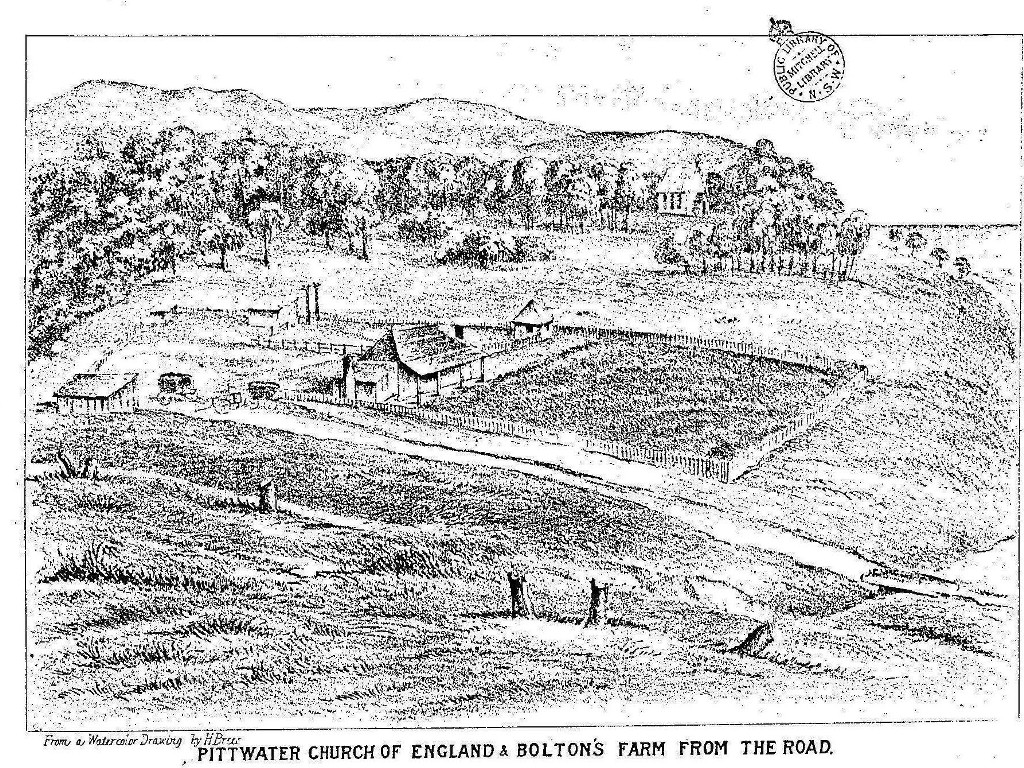
Pittwater Church of England and Bolton's Farm from the Road; illustration from the Pittwater and Hawkesbury Lakes Album. 1880, Courtesy the Mitchell Library, State Library of NSW.
After old Mr. Foley's murder, the cattle of his neighbours, Farrell and Collins, again grazed unchecked over the Mona Vale estate. The place since then has been let to several successive tenants; but the results, although not quite so tragical as in his case, have been fully as disastrous in a pecuniary point of view. It would occupy too much space to enter into a detail hereof all that has taken place at Mona Vale during the last fifteen years ; and we will, therefore, proceed to give a short outline of the trials and losses of Mr. Therry, the present tenant.
Mr. James Therry, a relative of the late venerable Father Therry, and also of Judge Therry, arrived in New South Wales, with Mrs. Therry, a family of eight children, and an old and attached servant, by the ship Queen of Australia, about the middle of 1862. Mr. Therry had held a good Government appointment at home, which he left to come to this colony, at the invitation of his relative, the late Father Therry. A few days after his arrival, Mr. Therry went on an excursion to Pitt Water, and while there was charmed with the scenery, fertility, and appearance of the Mona Vale estate, which was then unoccupied. He had resolved to enter into farming pursuits, and thinking, from its proximity to the metropolis, and the advantages it seemed to possess, that Mona Vale would suit his purpose exceedingly well, he soon became its tenant. The house, which was then in a dilapidated state, was soon put into a fit condition for the residence of a respectable family ; the fences were repaired, valuable livestock was purchased, and the necessary farming implements provided. Mr. Therry intended to carry on dairy farming on a large scale, and amongst his stock were about fifty choice milch cows, selected from the best herds in the colony. The house was furnished at a cost of about £150, and Mrs. Therry and her large family were about to occupy it, when Mr. Therry, having gone to Sydney to make arrangements for their removal, found, when he returned to the spot with his wife and children, the place reduced to ashes. The fiendish incendiary had gone to work during his absence, set fire to the place, and totally consumed both the dwelling house and out offices. Nothing was left in which the family could take shelter, and a respectable household of eleven persons, accustomed to every comfort and convenience, was reduced to the necessity of erecting a refuge from the weather, composed of sods, pieces of canvas, and such few odds and ends as had escaped destruction. In this wretched abode they lived for several months — fearing if they left the spot for an hour that their live stock, now their only dependence, would be driven off or destroyed.
The writer of this notice, a short time after the fire, happened to pass through the district. At the remains of the ruined homestead, he saw standing near what had been the hearth of the burnt dwelling-house, a woman, who, from her manners and conversation, was evidently a lady. A number of young children were gathered round a small hovel which had been erected on a rising ground beyond. These persons and their surroundings appeared so singular and so incompatible with each other, as to lead to inquiries, and the result is now before the reader.
At the inquest on the fire, evidence was given which threw strong suspicion upon Farrell as the incendiary ; and the coroner expressed in very plain terms his opinion of his guilt ; but the jury did not think there was sufficient evidence to justify a verdict against him.
The burning of their house was but the beginning of the troubles of the Therry family. Not-withstanding all their watchfulness, a few days afterwards, several of their cattle were found dead. They had been driven into nearly inaccessible gulleys and shot. In a short time three or four others disappeared, and after a long search their carcases were discovered — all bearing marks of gunshot wounds. The next loss was the disappearance of ten milch cows. A few days after this occurrence, as Mr. Therry could discover the carcases of but nine animals, he procured a search warrant and found on Farrell's premises the remains of a recently slaughtered cow. One of the missing cows had been a favourite with the Therry family, from the fact of having a peculiar mark on her coat, which they said resembled the shape of Ireland on the map. They called her Tuffy, and with that clinging recollection of old country associations which people of Irish birth retain in such intensity, the cow, from the circumstance to which we have referred, was treated as a pet, and the peculiarity of the mark frequently referred to. They were accordingly able to identify a part of a hide discovered at Farrell's place as that of the cow in question. Proceedings were thereupon taken against Farrell, and he was committed for trial, but allowed bail. In the mean-time the Therrys, being in daily dread of assassination, had applied for and obtained the protection of an officer of police, who often remained on the premises day and night. Still their cattle were slaughtered, their fences destroyed, and other depredations committed as before. Their whole stock was by this time reduced to seventeen cows and two horses. The weather during the greater part of the time they remained in the hovel they had at first constructed was most unfavourable, and after some months they were enabled to erect a rough building of slabs. They were, by this time all but utterly ruined. The frequent attendances which they had been obliged to give at the Police Court in Sydney, and the cost to which they were put in procuring legal advice and in prosecuting their oppressors, had exhausted all the means at their command, while they were prevented by almost constantly recurring troubles and annoyances from attending to the affairs of the farm, and making the best of the few that were left of their dairy cows.
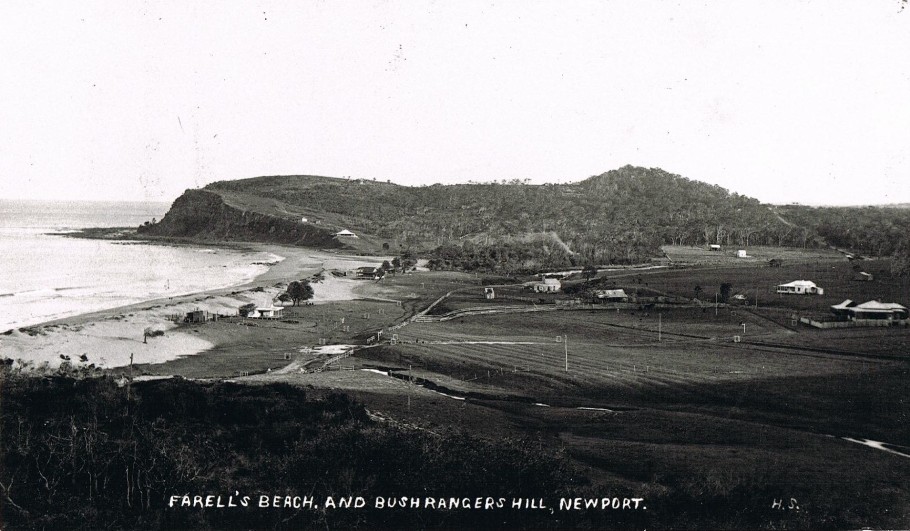
Farrell's Beach and Bushrangers Hill, Newport from Small Picture File, Courtesy Mitchell Library.
In the midst of all their troubles, almost the only friend and relative they had in the country, the Rev. Father Therry, died suddenly. Their landlord, the late Captain Darley, who had taken much interest in their affairs, had died in a similarly sudden manner a short time before. Father Therry's will had been made many years previously to the Therry family coming to the country, and contained no provision for their benefit, although it is probable, if his life had been spared a little longer, that he would have disposed of a part, at least, of his property differently.
Their few well disposed neighbours were almost unanimous in advising the Therry family to leave Mona Vale, in order to save their lives. But Mr. Therry, rendered desperate by his losses and the treatment he had received, determined never to leave the place while there was a chance of obtaining justice against his oppressors.
Mrs. Therry and the female portion of the family, were, however, removed to Manly Beach. The father and four boys, mere children, remained on the spot. With firearms inconstant readiness, the father mostly watched at night and the children by day. Their case had grown so urgent, previous to this, that the Government had thought it necessary to place two constables (one of them a mounted trooper)in their immediate neighbourhood. Still the work of destruction went on, and at last the whole of their remaining milch cows, seventeen in number, were swept off at once ; and so secretly was this effected that their carcases even could not be discovered for a long time.
The well-disposed part of the neighbours —all who had shown the Therry family the slightest sympathy or afforded them the smallest assistance — were likewise placed under the ban of the wretches who had treated them so shamefully. Some of their animals were driven off or destroyed, and they as well as the Therrys lived in a constant state of terror ;seldom venturing out unarmed, and being in dread of having their houses burnt over their heads. They are in this state at the present moment. To their credit, however, be it said, they did not allow a feeling of selfishness to deter them from doing their duty. Though they numbered but five or six families in all, they subscribed one hundred pounds as a reward for the discovery of the perpetrator or perpetrators of the atrocious crimes to which we have above referred. The Government added fifty pounds to the reward of one hundred, offered by the neighbours, and, in addition to the two policemen already on the spot, sent McGlone, the detective officer who had just previously captured Gardiner, with instructions to spare no exertions in detecting the guilty parties and bringing them to justice.
In the meantime, pending these arrangements, Farrell had been brought to trial for stealing and slaughtering Mr. Therry's cow. The evidence of Mrs. and Miss Therry as to the peculiar mark on the hide, "resembling Ireland on the map,” was clear and distinct, but Mr. Isaacs, as counsel for the prisoner, contended that even allowing, for the sake of argument, that the piece of hide produced was that of the cow in question, it only proved that Farrell had made a mistake and killed Therry's cow instead of his own. Eleven of the jury were for a conviction, but one stood out, and they were ultimately discharged without arriving at a verdict ; the prisoner being remanded on bail, until the next sitting of the court.
Mr. Therrys live stock had been reduced to two horses when McGlone appeared upon the scene. That officer commenced his investigations very skilfully and cautiously, and did not take any open steps until he had made himself acquainted with the characters, habits, and circumstances of the people of the district.
Farrell's first step on being allowed bail was to institute a prosecution against Mrs. and Miss Therry for perjury, in swearing that the piece of hide found on his premises was that of their cow Tuffy. The animal in question had, it appears, very peculiar horns, one of them being broken and hanging down at the side of her head. Farrell, in his evidence at the Police office, against Mrs. and Miss Therry, produced the head of a bullock which he stated to be that of the one from which the piece of hide sworn to as having belonged to Tuffy was taken. It was evident that, if Farrell's story was true, Mrs. and Miss Therry must have committed perjury, because the horns of the head produced were very different from those described as having belonged to Tuffy. It was noticed when this bullock's head was produced in court by Farrell that he handled it very tenderly. This might be accounted for perhaps from its dirty condition, its appearance being as if it had lain in a mud hole. Some of the hair remained on the head, but its colour could scarcely be ascertained on account of the mud with which it was encrusted. The magistrate, Mr. George Hill, in order to ascertain the real colour of the hair, and perhaps suspecting something wrong from the gingerly way in which Farrell handled the head, ordered it to be taken out and washed. When this was done it was discovered that not only was the colour of the hair different from that of the piece of hide, but that the horns were actually fastened on the head by artificial means ! They were secured in their places by small French nails.
On this discovery, Mrs. and Miss Therry were of course discharged at once. But it may give some idea of the annoyance and expense to which they were put by repeated journeys to Sydney, and in defraying legal and other costs, when we state that the investigations connected with these two cases at the Police Court extended over a month.
Detective McGlone, after a time, discovered a means by which some, at least, of the crimes committed might be brought home to the guilty parties. There had been in the service of Farrell for several years a youth named Malcolm Turner. This young man absconded from Farrell's place shortly after the last of Therry's cattle —that is, the seventeen milch cows — had been destroyed. It was believed that this youth could, if he liked, give such information as would throw considerable light upon the affair. He was discovered residing at Lane Cove, and after some time, agreed to point out to a Mr. McMahon the spot where the remains of the slaughtered animals were to be seen. He said he left Farrell's place because, having a knowledge of the crimes which had been committed, he considered his life in danger while he remained there. He took the person to whom he made this communication at once to the place where the seventeen carcases lay. It was an almost inaccessible gully. He also pointed out, at other places, the carcases of other cattle of Therry's which had been destroyed. His story was that he had been sent with Poyner to drive the seventeen head to where they had been shot. That Poyner had shot all except one or two, which he, Turner, shot at Poyner's command, being under fear of the consequences if he refused. He stated that he had previously assisted Farrell in killing the ten head, of which Tuffy was one, in much the same way as he had afterwards assisted Poyner. He had at first refused, but Farrell having taunted him with cowardice and not being " game," and fearing the consequences to himself if he did not comply, he had at last shot one of them — Farrell shooting the others himself.
With this additional evidence of Turner’s Farrell was again placed upon his trial. The case against him was now complete, and after a trial extending over several days, during which a number of very remarkable facts came to light, he was, on the 30th ultimo, convicted and sentenced to seven years' hard labour. Criminal prosecutions were also instituted against Mrs. Farrell, and Poyner, but the cases against them have not yet come before a jury.
Many extraordinary facts in addition to those above related, have come to our knowledge in connection with the Mona Vale crimes, and the persecutions of the Therry family, but as they involve charges in cases where no legal proceedings have been taken, and consequently do not rest upon sworn testimony, we think it advisable not to relate them at present.
Persons who have never visited the district of Pitt Water will probably wonder how such a series of crimes, extending over many years, could have been committed with impunity. It will be difficult for a stranger to the neighbourhood to comprehend how cattle could be killed, or driven away, while their owners were almost constantly on the watch. To those who know the place the matter needs no explanation. The district consists of a series of bold headlands, sandhills, lagoons, and gullies. The country is for the most part covered with thick scrub, and scarcely any of the houses are less than two miles distant from each other. The largest portion of the estates are almost entirely unfenced, and consequently it is impossible to keep cattle always insight, and often difficult to find them when they are almost close at hand.
The district is a very picturesque one. The road, or rather pathway through it, winds about— sometimes on the verge of lofty cliffs, sometimes through deep gullies, where the cabbage-tree and tree fern flourish, sometime over bleak hills and sandy dunes, descending at times to fertile grassy flats, and intercepted at places by pretty lagoons and babbling brooks. One or two of the cottages are pictures of rural taste and neatness. The whole district being nearly surrounded by the waters of Broken Bay on the one side, and those of Port Jackson on the other, and there being no practicable road by which it can be reached from Sydney, either in a vehicle or on horse-back, although within little more than a dozen miles as the crow flies, it has remained for many years almost unknown, and, to a certain extent, shut in from the inhabitants of the rest of the colony. To this circumstance is perhaps to be ascribed the comparative impunity with which crime has been perpetrated, and the little attention the strange facts above related have hitherto received in Sydney. It is hardly necessary to say, after the above disclosures, that there is not and never has been such a thing as a church, chapel, or school-house in the whole district.
The thanks of the community are due to detective McGlone for the energy and sagacity with which he has acted in bringing Farrell to justice. It is to be hoped that the proceedings which have been initiated against others will be prosecuted to a successful issue, if they are guilty —for it is melancholy to know — as we are assured is the case — that the few respectable inhabitants at Pitt Water are still living in constant fear not only of the destruction of their property but of their lives. Mr. Therry and his boys still stick to their hut, although all their property is destroyed, determined not to budge while one of the gang remains unconvicted. THE STORY OF MONA VALE. (1865, January 20). Empire(Sydney, NSW : 1850 - 1875), p. 5. Retrieved from http://nla.gov.au/nla.news-article60564465
TO THE EDITOR OF THE EMPIRE.
Sir, — Having read with much interest your " Story of Mona Vale" may I bring before your notice, or rather the notice of the public, one party to whom the inhabitants of Pitt Water are much indebted — I mean Constable John Sheaves, of the Manly district. To him we are indebted for the first discovery of the piece of cowhide, being a portion of the hide of one of my cows, for which Farrell was prosecuted in 1863, and to whose sterling honesty and unshrinking perseverance in the discharge of his duty, by bringing every legal means to bear upon the suppression of crime, too much praise cannot be bestowed.
If an honest man and a faithful servant can add efficiency to a government department, the police authorities may be proud of Mr. Sheaves.
I have the honor to be, Sir,
Your obedient servant,
JAMES THERRY.
[In connexion with what appeared in the Empire respecting Mona Vale, we take this opportunity of stating that we have been requested by a relative of the late Mr. Foley to say that he occupied the estate in question many years earlier than the date we mentioned, and that, although he was for a short time a constable, he accepted that position only that he might be the better able to protect his property, and deal with the lawless characters in his neighbourhood. — Ed. Empire.] TO THE EDITOR OF THE EMPIRE. (1865, January 25). Empire(Sydney, NSW : 1850 - 1875), p. 5. Retrieved from http://nla.gov.au/nla.news-article60564744
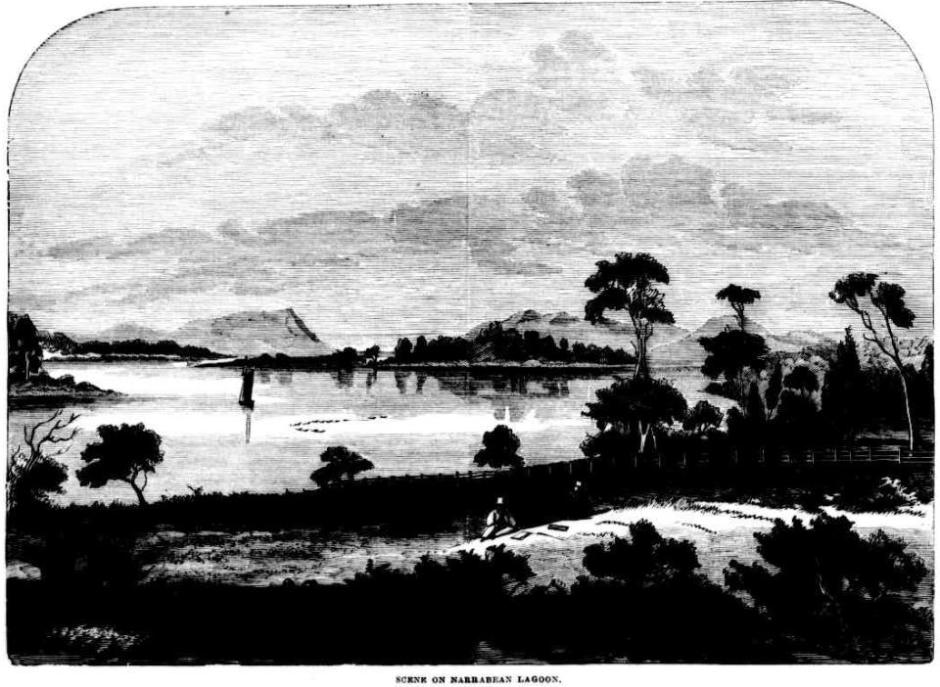
'SCENE ON NARRABEAN LAGOON.' Narrabean and Mona Vale. (1877, January 6). Australian Town and Country Journal (Sydney, NSW : 1870 - 1907), , p. 20. Retrieved from http://nla.gov.au/nla.news-article70598057
Above: 'SCENE ON NARRABEAN LAGOON.'
Narrabean and Mona Vale.
THERE are few spots about Sydney more picturesque and interesting than Narrabean and Mona Vale, Pitt Water, and the wonder is that more visitors from the noisy and dusty metropolis do not find their way to these peaceful sylvan scenes, to rusticate and recruit their flagging energies. Fish abound in the lagoon, and at the present season there is no lack of game in the underbrush near the shore, and the ridges that extend towards the higher country at the back. In addition to this, the character of the whole place is different from anything that is met with in any other part of the metropolitan districts; and as the eye takes in the prospect afforded, particularly at Narrabeen, one who knows the history of the locality can hardly help being impressed with the idea that it is a picture full of sad memories and mournful recollections. Right before the visitor, as he stands upon the piece of elevated land overlooking the lagoon, extends a fine stretch of grassy country, almost as level as a race-course Though within a few yards of the ocean, not a rock or sign of such proximity is visible, and the whole reach is protected from the violence of storms by a belt of thick forest which margins the ocean throughout. At the back rugged ridges rise precipitously, and these being clad with foliage to their very crown, add much to the sense of beauty and security, as it were, of the whole place. Hereabout are evidences of a once busy time; but desolation now presents itself on every hand. The houses are in ruins, and the fences dilapidated, and one sees nothing now but what indicates a marvellous chance from the past ; remnants of once comfortable homesteads show themselves, and time indeed seems here to have destroyed all that the energy and industry of man once sought to produce or rear up. Turning round, and looking in a north-easterly direction, an enchanting view meets the eye. Our artist has endeavoured, in the accompanying engraving, to depict some of its beauty. Almost at one's foot the placid waters lie like a mirror, over an area of several miles, till the ridges push in their rugged outlines on either side, and thus intercept the view; but then, farther on, the eye catches a glimpse of a piece of cultivated country, where, one would think, a man might dwell in peace and quiet all his days. To the right the lagoon extends towards the ocean, from which it is separated by a sandy bar, which, however, allows of overflow one way and the other according to the circumstances of the hour. Cranes and aquatic birds abound, but there is very little sign of human life during the greater part of the year. At certain seasons, however, a few fishermen come to the place for a few weeks' stay, and with the aid of their boat and net are able to make the visit profitable. Our view shows their boat upon the lake, moving silently along as a thing of life. No more enchanting sight presents itself than this when observed at an early hour- as day breaks, and the gloom disappears, and each headland and bay is lit up, and the whole scene which lies before the eye presents a magnificent panorama of undisturbed nature. Turning again to the ruins, one wonders why such a spot should be I deserted, and the mind is by degrees induced to picture the past, and ask where are those busy hands that first broke in upon this silent scene-that in old times toiled and toiled from day to day beneath the burning sun, to gather about them the comforts of civilisation - all scattered or fallen into disrepair and ruin. Each stone has its history, and the decayed and tottering posts erected by industrious hands tell of the men who have long since passed over to the majority.
But all must be left to the imagination; there is no one about to reveal the past; nothing seems to live or flourish, save a gigantic cabbage-tree, which rears its head fifty or sixty feet, and, defiant of both time and tempest, looks complacently down on the surrounding scene of desolation. Of late years the place has been in the possession of the Jenkins family, whose members have won for themselves the esteem of all the residents of the district, and whose generous hospitality is spoken of by every one who visits Narrabean. Their homestead is situated a short distance in from the coast, at Long Reef, and its unobtrusive yet comfortable appearance reminds one of an English country home. The land at Narrabean is not now cultivated; the soil has been worked out long ago, but a few sheep and cattle are frequently depastured there. Wherever one looks in this district, the scenery presents an aspect totally different from what is usually met with on the coast, as here is found a long stretch of land within a stone throw of the ever-rolling ocean, originally of great fertility, but exhausted by long cropping and careless cultivation. It is much the same with the Mona Vale estate, which is situated about three miles on the opposite side of Narrabean, and usually reached by crossing the lagoon in its shallowest part, which is about the centre. As one wends his way along through the bush, and Mona Vale opens out before him, he stands to behold and enjoy the novel view that presents itself ; it is so secluded and quiet, and yet so grand, with the rugged ridges on the one hand, and the turbulent ocean on the other, that it singularly impresses the visitor, who becomes eager to learn its history, and feels sure there must be many pleasant reminiscences to tell of past occupants. What a sad mistake ! What fearful trials and losses and disappointments have been experienced here. Its history should be written in blood, for if ever red-handed crime flourished in any country, it flourished and triumphed here, till it brought ruin and death to honest people; and justice, outraged beyond bearing, rushed in and brought the delinquents to punishment. The description of these places has already taken up all the space that can be afforded, so we must defer till a future opportunity a brief outline of the leading incidents in their history. Narrabean and Mona Vale. (1877, January 6). Australian Town and Country Journal (Sydney, NSW : 1870 - 1907), , p. 20. Retrieved from http://nla.gov.au/nla.news-article70598057
MONA VALE.
A concert and social in aid of the Catholic Church was hold at Mona Vale recently. The programme was a lengthy and enjoyable one, and the audience was appreciative. The contributors wore: Misses Aylmor (2), Clark, M. McLean, Welton, E. Sheldon, M. Brown, M. Johnson, O. McLean, A. McLean E. Olding, Maggie Keaty, Mrs. H. O'Hara, Messrs. Burton, and A. J. 'Moore, and Baby Sheldon. The entertainment was a success in every way. The result was £7 6s, which was very satisfactory for such a sparsely-populated district. The committee was: Mr. and Mrs. J. T. Collins, Misses M. and F. McLean, Mrs. Roche, Mr. and Mrs. C. J. Devlin. Mr. Devlin was Hon. secretary. MONA VALE. (1907, January 24). The Catholic Press (Sydney, NSW : 1895 - 1942), , p. 19. Retrieved from http://nla.gov.au/nla.news-article106285318
BROCK'S MANSION BURNED.
News of the World by Our .independent Cable Service,
BIG BLAZE AT MONA VALE. beautiful landmark destroyed, damage estimated at £12,000. No fire-fighting appliances available.
"La Corniche," a mansion at Mona "Vale, which occupied a commanding position on the road between Manly and Newport, was destroyed by fire early this morning. Flames were discovered at 10 minutes to 1. At half-past 2 only portions of the walls, and they rickety, were standing.
The building was palatial In Its dimensions and appointments, and contained in all 38 rooms, 28 of which were bedrooms. It was originally designed for The Oaks Polo Club, and was built by Mr. G. S. Brock at a cost which has been set down at £32,000. Before the building was completed, however,. It was acquired by Mr. Arthur Rickard, who brought It up to date and then let It to M. and Mme. Rainaud, at one time chef to Sir Harry Raw-son. Instead of being used as a polo club it became a fashionable boarding house, and on account of its situation and Us surroundings, including surfing and golf, it became exceedingly popular. There were 30 boarders in the place at the time of the fire. -The fire started in the large dining hal, and was discovered before it had a very strong hold of the room, but not in time to be beaten out. There was a hue and cryas it raced throughout the building, and boarders were running to and fro to ascertain the extent of, their danger and the possibilities of saving their effects. The flames spread with great rapidity, but happily not in the direction of the staircase, and many of the people were, therefore, able to dash about and get their property outside. Those on the second and third floors, however, did not take the risk which running up and down the stairs involved, and threw most of their belongings out of the windows. In ten minutes the flames had begun to light up the hills on either side, and to throw long reflections out to sea. The boarders were all out of the building by this .time, and the menfolk were assisting the staff (numbering 20) to remove the furniture. They continued in this until the flames drove them back, and were successful in getting out a piano and other big stuff. But what was saved was a mere fraction of what was lost. All that the people could do was to stand by and watch. There was water— the sea could be heard roaring in to shore all the time — but there was no means of pumping it into the building. No fire-fighting appliances which would avail anything were kept on the premises, there is no depot in the vicinity, and though a boarder motored to Manly post haste and reported the blaze the firemen did not go out, because they could have done nothing if they had. There were very few incidents in connection with the fire. Everybody was got out expeditiously, and though there were several cases where ladies fainted they were never in danger.
Even the pets of the house were though one had a lucky escape. It was a little white pussy, and it mewed and mewed pitifully on the window sill of a room from which smoke was already issuing. One of the girls attached to the staff saw its plight and darted into the building and out again with her charge in a few seconds. Mr. Scott Fell, who has a house in the grounds of La Corniche, provided accommodation for the boarders for the rest of the night. As bad as the consequences were they might have been worse. If the blaze, for instance, had started nearer to the stairway than it did, it is quite possible that the escape of the boarders would have been cut off, and the only exit would have been through the windows, a course . of action which would practically have endangered limbs if not life. Then, again, the wind was blowing out to sea. Had it blown from the sea, it Is not unlikely that two cottages and the Casino, nearer the roadway, would have gone, while the motor garage, where four motor-cars were kept, would almost certainly have been gutted. The most remarkable circumstance in connection with the fire was associated with the telephone. When the blaze was found to be so serious Mr. A. Davis tore the phone from the wall and carried it outside. Later in the morning an electrician fitted it up on to the fence— the only piece of the fence which escaped the flames— and a trial showed that though the wires had been through the heat of the flames, the 'phone was still -In : order, and the Manly exchange could be distinctly heard. The boarders relished the good fortune, because it enabled them to send reassuring messages to their friends. Mr. Rickard stated this morning that the building and furniture was insured in the New Zealand Insurance Co. for £6000, and that he was therefore a fairly heavy loser, seeing that his estimate of the value of the building was £10,000. The furniture was valued at £2000. Mrs. Mueller (wife of Dr. Mueller, of Macquarie-street), Messrs. Harvey, A. Davis, Earle Hermann, Toohey, L. A. and R. V. Minnett, Lotrois, and others of the boarders, were also sufferers by the fire. Mr. Rainaud lost silver, linen, &c., to the value of £250, which was uninsured. The origin of the fire cannot he determined, but it is believed that it was caused by a lighted match or cigar butt carelessly thrown on to the carpet in the dining-room. Mr. Rainaud heard a noise in the dining-room, which she attributed to burglars, and on getting out of bed found the place ablaze.
Below: Mona Vale Hydro, the scene of a disastrous fire which occurred in the early hours of this morning. BROCK'S MANSION BURNED. (1912, January 8). The Sun (Sydney, NSW : 1910 - 1954), , p. 1. Retrieved from http://nla.gov.au/nla.news-article222004219
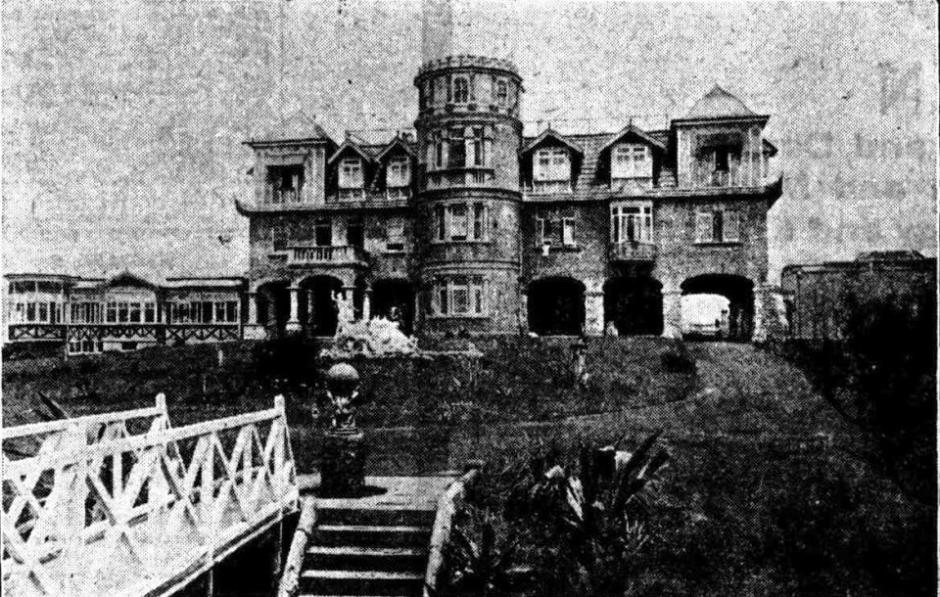
Mona Vale Public School 1906 to 2012 - threads collected by A J Guesdon, 2016.
Previous History Pages:
Marie Byles Lucy Gullett Kookoomgiligai Frank Hurley Archpriest JJ Therry Sir Patrick Gordon Taylor Bowen Bungaree W. Bradley 1788 Journal Midholme Loggan Rock Cabin La Corniche La Corniche II Lion Island Bungan Beach Botham Beach Scarred Trees Castles in the Sand Dame Nellie Melba lunches at Bilgola Spring, 1914 First to Fly in Australia at North Narrabeen Mona Vale Golf Club's Annual Balls Governor Phillip camps on Resolute Beach Ruth Bedford Jean Curlewis Mollie Horseman Charlotte Boutin May Moore Neville W Cayley Leon Houreux Frederick Wymark Sir Adrian Curlewis Bilgola Heron Cove Mullet Creek Shark Point Woodley's Cottage A Tent at The Basin Collin's Retreat-Bay View House-Scott's Hotel Bilgola Cottage and House The First Pittwater Regatta Women Cricketers Picnic Filmed In Pittwater Governor Phillip's Barrenjoey Cairn Waradiel Season The Church at Church Point Governor Phillip's Exploration of Broken Bay, 2 - 9 March 1788 Petroglyths: Aboriginal Rock Art on the Northern Beaches Avalon Headland Landmarks Steamers Part I Pittwater Aquatic Club Part I Woody Point Yacht Club Royal Motor Yacht Club Part I Dorothea Mackellar Elaine Haxton Neva Carr Glynn Margaret Mulvey Jean Mary Daly Walter Oswald Watt Wilfrid Kingsford Smith John William Cherry George Scotty Allan McCarrs Creek Narrabeen Creek Careel Creek Currawong Beach Creek Bushrangers at Pittwater Smuggling at Broken Bay An Illicit Still at McCarr's Creek The Murder of David Foley Mona Vale Outrages Avalon Camping Ground Bayview Koala Sanctuary Ingleside Powder Works Palm Beach Golf Course Avalon Sailing Club Mona Vale Surf Life Saving Club Palm Beach SLSC Part I - The Sheds Warriewood SLSC Whale Beach SLSC Flagstaff Hill Mount Loftus Pill Hill Sheep Station Hill S.S. Florrie S.S. Phoenix and General Gordon Paddlewheeler MV Reliance The Elvina Florida House Careel House Ocean House and Billabong Melrose-The Green Frog The Small Yacht Cruising Club of Pittwater Canoe and I Go With The Mosquito Fleet - 1896 Pittwater Regattas Part I - Dates and Flagships to 1950 Shark Incidents In Pittwater The Kalori Church Point Wharf Bayview Wharf Newport Wharf Palm Beach Jetty - Gow's Wharf Max Watt Sir Francis Anderson Mark Foy John Roche Albert Verrills Broken Bay Customs Station At Barrenjoey Broken Bay Water Police Broken Bay Marine Rescue - Volunteer Coastal Patrol Pittwater Fire-Boats Prospector Powder Hulk at Towler's Bay Naval Visits to Pittwater 1788-1952 Pittwater's Torpedo Wharf and Range Naval Sea Cadets in Pittwater S.S. Charlotte Fenwick S.S. Erringhi P.S. Namoi S.Y. Ena I, II and III Barrenjoey Headland - The Lessees Barrenjoey Lighthouse - The Construction Barrenjoey Broken Bay Shipwrecks Up To 1900 Barrenjoey Light Keepers Douglas Adrian Ross Newport SLSC 1909 - 1938 Part I Overview North Narrabeen SLSC - The Formative Years Bilgola SLSC - the First 10 years North Palm Beach SLSC A History of Pittwater Parts 1 and 4 Pittwater Regattas - 1907 and 1908 Pittwater Regattas - 1921 - The Year that Opened and Closed with a Regatta on Pittwater Pittwater Regatta Banishes Depression - 1933 The 1937 Pittwater Regatta - A Fashionable Affair Careel Bay Jetty-Wharf-Boatshed Gow-Gonsalves Boatshed -Snapperman Beach Camping at Narrabeen - A Trickle then a Flood Pittwater's Parallel Estuary - The Cowan 'Creek' RMYC Broken Bay Boathouse and Boatshed Barrenjoey Boat House The Bona - Classic Wooden Racing Yacht Mona Vale Hospital Golden Jubilee - A Few Insights on 50 Years as a Community Hospital Far West Children's Health Scheme - the Formation Years The First Scotland Island Cup, Trophy and Race and the Gentleman who loved Elvina Bay Royal Motor Yacht Club Broken Bay NSW - Cruiser Division History - A History of the oldest division in the Royal Motor Yacht Club Royal Motor Yacht Club Broken Bay Early Motor Boats and Yachts, their Builders and Ocean Races to Broken Bay, the Hawkesbury and Pittwater The Royal Easter Show Began As the Royal Agricultural Society of New South Wales The Mail Route to Pittwater and Beyond The Wild Coachmen of Pittwater - A Long and Sometimes Bumpy Ride on Tracks Instead of Roads The Fearless Men of Palm Beach SLSC's Surf Boats First Crews - A Tale of Viking Ships, Butcher Boats and Robert Gow's Tom Thumb 'Canoe' Furlough House Narrabeen - Restful Sea Breezes For Children and Their Mothers From Telegraphs to Telephones - For All Ships at Sea and Those On Land Mona Vale Training Grounds - From Lancers on Horses to Lasses on Transport Courses Fred Verrills; Builder of Bridges and Roads within Australia during WWII, Builder of Palm Beach Afterwards Communications with Pittwater Ferries To Pittwater A History of Pittwater - Part 4: West Head Fortress Pittwater's Lone Rangers - 120 Years of Ku-Ring-Gai Chase and the Men of Flowers Inspired by Eccleston Du Faur Early Pittwater Launches and Ferries Runs Avalon Beach SLSC - The First Clubhouse Avalon Beach SLSC The Second and Third Clubhouses From Beneath the Floorboards at Hyde Park Barracks Bungaree Was Flamboyant Andrew Thompson - 'Long Harry' Albert Thomas Black John Collins of Avalon Narrabeen Prawning Times - A Seasonal Tide of Returnings Oystering in the Pittwater Estuary - Oyster Kings and Pearl Kings and When Not to Harvest Oysters Yabbying In Warriewood Creeks Eeling in Warriewood's Creeks (Includes A Short History of community involvement in favour of environmental issues/campaigns in and around Narrabeen Lagoon - 1974 to present by David James OAM) Eunice Minnie Stelzer - Pittwater Matriarchs Maria Louisa Therry - Pittwater Matriarchs Katherine Mary Roche - Pittwater Matriarchs Sarah A. Biddy Lewis and Martha Catherine Bens Pittwater Matriarchs Pittwater's New Cycle Track of 1901 Manly to Newport The Rock Lily Hotel Barrenjoey House The Pasadena Jonah's St Michael's Arch The First Royal Visitor to Australia: the Incident at Clontarf March 12th, 1868 Pittwater: Lovely Arm of the Hawkesbury By NOEL GRIFFITHS - includes RMYC Wharf and Clareville Wharf of 1938 + An Insight into Public Relations in Australia George Mulhall First Champion of Australia in Rowing - First Light-Keeper at Barranjuey Headland Captain Francis Hixson - Superintendent of Pilots, Lights, and Harbours and Father of the Naval Brigade The Marquise of Scotland Island The First Boat Builders of Pittwater I: the Short Life and Long Voyages of Scotland Island Schooner theGeordy Boat Builders of Pittwater II: from cargo schooners and coasters to sailing skiffs and motorised launches The Currawong: Classic Yacht The Riddles of The Spit and Bayview/Church Point: sailors, boat makers, road pavers and winning rowers VP Day Commemorative Service 2015 – at Avalon Beach RSL Cenotaph: 70th Anniversary Captain T. Watson and his Captain Cook Statues: A Tribute to Kindness Pittwater Reserves: The Green Ways; Hordern or Wiltshire Parks to McKay Reserve – From Beach to Estuary Pittwater Reserves, The Green Ways: Clareville Wharf and Taylor's Point Jetty Pittwater Reserves: The Green Ways Bilgola Beach - The Cabbage Tree Gardens and Camping Grounds - Includes Bilgola - The Story Of A Politician, A Pilot and An Epicure by Tony Dawson and Anne Spencer Pittwater Reserves - The Green Ways: Mona Vale's Village Greens a Map of the Historic Crown Lands Ethos Realised in The Village, Kitchener and Beeby Parks Pittwater Reserves: The Green Ways; Bungan Beach and Bungan Head Reserves: A Headland Garden Early Pittwater Paddlers, Oarsmen, Rowers and Scullers: The Green Family Elanora - Some Early Notes and Pictures The Stewart Towers On Barrenjoey Headland Early Pittwater Paddlers, Oarsmen, Rowers and Scullers: The Williams Family Early Cricket in Pittwater: A small Insight Into the Noble Game from 1880's On The Pacific Club's 2016 Carnival in Rio Fundraiser for Palm Beach SLSC Marks the 79th Year of Support Bert Payne Park, Newport: Named for A Man with Community Spirit Early Pittwater Paddlers, Oarsmen, Rowers and Scullers: The Fox Family Surf Carnivals in February 1909, 1919, 1925, a Fancy Dress Rise of Venus and Saving Lives with Surfboards Early Pittwater Paddlers, Oarsmen, Rowers and Scullers: The Paddon Family of Clareville Mermaid Basin, Mona Vale Beach: Inspired 1906 Poem by Viva Brock Early Pittwater Schools: The Barrenjoey School 1872 to 1894 The Royal Easter Show and 125th Celebration of the Hawkesbury Agricultural College: Farmers Feed Us! The Newport School 1888 to 2016 Pittwater's Ocean Beach Rock Pools: Southern Corners of Bliss - A History The Royal Botanical Garden Sydney Celebrates 200 Years in 2016 The Porter Family of Newport: Five Brother Soldiers Serve in WWI Church Point and Bayview: A Pittwater Public School Set on the Estuary The Basin, Pittwater: A Reprise: Historical Records and Pictures Lighthouse Keepers Cottages You Can Rent in NSW - Designed or Inspired by Colonial Architect James Barnet: Includes Historic 'Lit' Days records Bayview Days